
Sign
Section 2D.01 Scope of Conventional Road Guide Sign Standards
Standard:
01 The provisions of this Chapter shall apply to any road or street other than low-volume roads (as defined in Section 5A.01), expressways, and freeways.
Section 2D.02 Application
Support:
01 Guide signs are essential to direct road users along streets and highways, to inform them of intersecting routes, to direct them to cities, towns, villages, or other important destinations, to identify nearby rivers and streams, parks, forests, and historical sites, and generally to give such information as will help them along their way in the most simple, direct manner possible.
02 Chapter 2A addresses placement, location, and other general criteria for signs.
Section 2D.03 Color, Retroreflection, and Illumination
Support:
01 Requirements for illumination, retroreflection, and color are stated under the specific headings for individual guide signs or groups of signs. General provisions are given in Sections 2A.07, 2A.08, and 2A.10.
Standard:
02 Except where otherwise provided in this Manual for individual signs or groups of signs, guide signs on streets and highways shall have a white message and border on a green background. All messages, borders, and legends shall be retroreflective and all backgrounds shall be retroreflective or illuminated.
Support:
03 Color coding is sometimes used to help road users distinguish between multiple potentially confusing destinations. Examples of valuable uses of color coding include guide signs for roadways approaching or inside an airport property with multiple terminals serving multiple airlines, and community wayfinding guide signs for various traffic generator destinations within a community or area.
Standard:
04 Except where otherwise provided in this Manual, different color sign backgrounds shall not be used to provide color coding of destinations. The color coding shall be accomplished by the use of different colored square or rectangular sign panels on the face of the guide signs.
Option:
05 The different colored sign panels may include a black or white (whichever provides the better contrast with the panel color) letter, numeral, or other appropriate designation to identify an airport terminal or other destination.
Support:
06 Two examples of color-coded sign assemblies are shown in Figure 2D-1. Section 2D.50 contains specific provisions regarding Community Wayfinding guide signs.
Figure 2D-1 Examples of Color-Coded Destination Guide Signs
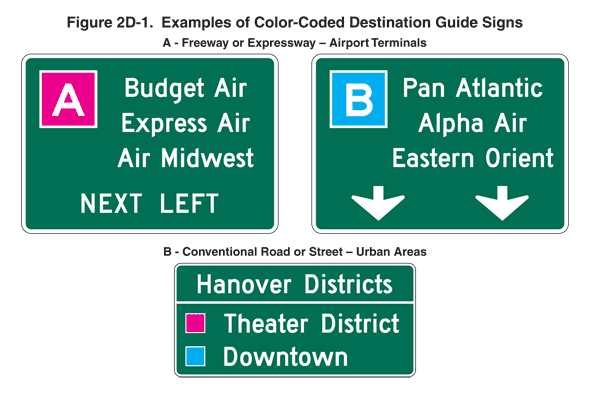
Section 2D.04 Size of Signs
Standard:
01 Except as provided in Section 2A.11, the sizes of conventional road guide signs that have standardized designs shall be as shown in Table 2D-1.
| Sign | Sign Designation | Section | Conventional Road | Minimum | Oversized |
|---|---|---|---|---|---|
| Interstate Route Sign (1 or 2 digits) | M1-1 | 2D.11 | 24 x 24 | 24 x 24 | 36 x 36 |
| Interstate Route Sign (3 digits) | M1-1 | 2D.11 | 30 x 24 | 30 x 24 | 45 x 36 |
| Off-Interstate Route Sign (1 or 2 digits) | M1-2,3 | 2D.11 | 24 x 24 | 24 x 24 | 36 x 36 |
| Off-Interstate Route Sign (3 digits) | M1-2,3 | 2D.11 | 30 x 24 | 30 x 24 | 45 x 36 |
| U.S. Route Sign (1 or 2 digits) | M1-4 | 2D.11 | 24 x 24 | 24 x 24 | 36 x 36 |
| U.S. Route Sign (3 digits) | M1-4 | 2D.11 | 30 x 24 | 30 x 24 | 45 x 36 |
| State Route Sign (1 or 2 digits) | M1-5 | 2D.11 | 24 x 24 | 24 x 24 | 36 x 36 |
| State Route Sign (3 digits) | M1-5 | 2D.11 | 30 x 24 | 30 x 24 | 45 x 36 |
| County Route Sign (1, 2, or 3 digits) | M1-6 | 2D.11 | 24 x 24 | 24 x 24 | 36 x 36 |
| Forest Route (1, 2, or 3 digits) | M1-7 | 2D.11 | 24 x 24 | 18 x 18 | 36 x 36 |
| Junction | M2-1 | 2D.13 | 21 x 15 | 21 x 15 | 30 x 21 |
| Combination Junction (2 route signs) | M2-2 | 2D.14 | 60 x 48* | â | â |
| Cardinal Direction | M3-1,2,3,4 | 2D.15 | 24 x 12 | 24 x 12 | 36 x 18 |
| Alternate | M4-1,1a | 2D.17 | 24 x 12 | 24 x 12 | 36 x 18 |
| By-Pass | M4-2 | 2D.18 | 24 x 12 | 24 x 12 | 36 x 18 |
| Business | M4-3 | 2D.19 | 24 x 12 | 24 x 12 | 36 x 18 |
| Truck | M4-4 | 2D.20 | 24 x 12 | 24 x 12 | 36 x 18 |
| To | M4-5 | 2D.21 | 24 x 12 | 24 x 12 | 36 x 18 |
| End | M4-6 | 2D.22 | 24 x 12 | 24 x 12 | 36 x 18 |
| Temporary | M4-7,7a | 2D.24 | 24 x 12 | 24 x 12 | 36 x 18 |
| Begin | M4-14 | 2D.23 | 24 x 12 | 24 x 12 | 36 x 18 |
| Advance Turn Arrow | M5-1,2,3 | 2D.28 | 21 x 15 | 21 x 15 | â |
| Lane Designation | M5-4,5,6 | 2D.33 | 24 x 18 | 24 x 18 | 36 x 24 |
| Directional Arrow | M6-1,2,2a,3,4,5,6,7 | 2D.29 | 21 x 15 | 21 x 15 | 30 x 21 |
| Destination (1 line) | D1-1 | 2D.39 | Varies x 18 | Varies x 18 | â |
| Destination and Distance (1 line) | D1-1a | 2D.39 | Varies x 18 | Varies x 18 | â |
| Circular Intersection Destination (1 line) | D1-1d | 2D.40 | Varies x 18 | Varies x 18 | â |
| Circular Intersection Departure Guide | D1-1e | 2D.40 | Varies x 42* | â | â |
| Destination (2 lines) | D1-2 | 2D.39 | Varies x 30 | Varies x 30 | â |
| Destination and Distance (2 lines) | D1-2a | 2D.39 | Varies x 30 | Varies x 30 | â |
| Circular Intersection Destination (2 lines) | D1-2d | 2D.40 | Varies x 30 | Varies x 30 | â |
| Destination (3 lines) | D1-3 | 2D.39 | Varies x 42 | Varies x 42 | â |
| Destination and Distance (3 lines) | D1-3a | 2D.39 | Varies x 42 | Varies x 42 | â |
| Circular Intersection Destination (3 lines) | D1-3d | 2D.40 | Varies x 42 | Varies x 42 | â |
| Distance (1 line) | D2-1 | 2D.43 | Varies x 18 | Varies x 18 | â |
| Distance (2 lines) | D2-2 | 2D.43 | Varies x 30 | Varies x 30 | â |
| Distance (3 lines) | D2-3 | 2D.43 | Varies x 42 | Varies x 42 | â |
| Street Name (1 line) | D3-1,1a | 2D.45 | Varies x 12 | Varies x 8 | Varies x 18 |
| Advance Street Name (2 lines) | D3-2 | 2D.46 | Varies x 30* | â | â |
| Advance Street Name (3 lines) | D3-2 | 2D.46 | Varies x 42* | â | â |
| Advance Street Name (4 lines) | D3-2 | 2D.46 | Varies x 60* | â | â |
| Parking Area | D4-1 | 2D.49 | 30 x 24 | 18 x 15 | â |
| Park â Ride | D4-2 | 2D.50 | 30 x 36 | 24 x 30 | 36 x 48 |
| National Scenic Byways | D6-4 | 2D.56 | 24 x 24 | 24 x 24 | â |
| National Scenic Byways | D6-4a | 2D.56 | 24 x 12 | 24 x 12 | â |
| Weigh Station XX Miles | D8-1 | 2D.51 | 78 x 60 | 60 x 48 | 96 x 72 |
| Weigh Station Next Right | D8-2 | 2D.51 | 84 x 72 | 66 x 54 | 108 x 90 |
| Weigh Station (with arrow) | D8-3 | 2D.51 | 66 x 60 | 48 x 42 | 84 x 78 |
| Crossover | D13-1,2 | 2D.55 | 60 x 30 | 60 x 30 | 78 x 42 |
| Freeway Entrance | D13-3 | 2D.48 | 48 x 30 | 48 x 30 | â |
| Freeway Entrance (with arrow) | D13-3a | 2D.48 | 48 x 42 | 48 x 42 | â |
| Combination Lane Use / Destination | D15-1 | 2D.35 | Varies x 96 | Varies x 96 | â |
| Next Truck Lane XX Miles | D17-1 | 2D.53 | 42 x 48 | 42 x 48 | 60 x 66 |
| Truck Lane XX Miles | D17-2 | 2D.53 | 42 x 42 | 42 x 42 | 60 x 54 |
| Slow Vehicle Turn-Out XX Miles | D17-7 | 2D.54 | 72 x 42 | 72 x 42 | 96 x 54 |
*The size shown is for a typical sign. The size should be determined based on the amount of legend required for the sign.
Notes:
- Larger signs may be used when appropriate
- Dimensions in inches are shown as width x height
Support:
02 Section 2A.11 contains information regarding the applicability of the various columns in Table 2D-1.
Option:
03 Signs larger than those shown in Table 2D-1 may be used (see Section 2A.11).
Support:
04 For other guide signs, the legends are so variable that a standardized design or size is not appropriate. The sign size is determined primarily by the length of the message, and the size of lettering and spacing necessary for proper legibility.
Option:
05 Reduced letter height, reduced interline spacing, and reduced edge spacing may be used on guide signs if sign size must be limited by factors such as lane width or vertical or lateral clearance.
Guidance:
06 Reduced spacing between the letters or words on a line of legend should not be used as a means of reducing the overall size of a guide sign, except where determined necessary by engineering judgment to meet unusual lateral space constraints. In such cases, the legibility distance of the sign legend should be the primary consideration in determining whether to reduce the spacing between the letters or the words or between the words and the sign border, or to reduce the letter height.
07 When a reduction in the prescribed size is necessary, the design used should be as similar as possible to the design for the standard size.
Section 2D.05 Lettering Style
Standard:
01 The design of upper-case letters, lower-case letters, numerals, route shields, and spacing shall be as provided in the "Standard Highway Signs and Markings" book (see Section 1A.11).
02 The lettering for names of places, streets, and highways on conventional road guide signs shall be a combination of lower-case letters with initial upper-case letters (see Section 2A.13). The nominal loop height of the lower-case letters shall be 3/4 the height of the initial upper-case letter. When a mixed-case legend letter height is specified referring only to the initial upper-case letter, the height of the lower-case letters that follow shall be determined by this proportion. When the height of a lower-case letter is referenced, the reference is made to the nominal loop height and the height of the initial upper-case letter shall also be determined by this proportion.
03 All other word legends on conventional road guide signs shall be in upper-case letters.
04 The unique letter forms for each of the Standard Alphabet series shall not be stretched, compressed, warped, or otherwise manipulated. Modifications to the length of a word for a given letter height and series shall be accomplished only by the methods described in Section 2D.04.
Section 2D.06 Size of Lettering
Support:
01 Sign legibility is a direct function of letter size and spacing. Legibility distance has to be sufficient to give road users enough time to read and comprehend the sign. Under optimum conditions, a guide sign message can be read and understood in a brief glance. The legibility distance takes into account factors such as inattention, blocking of view by other vehicles, unfavorable weather, inferior eyesight, or other causes for delayed or slow reading. Where conditions permit, repetition of guide information on successive signs gives the road user more than one opportunity to obtain the information needed.
Standard:
02 Design layouts for conventional road guide signs showing interline spacing, edge spacing, and other specification details shall be as shown in the "Standard Highway Signs and Markings" book (see Section 1A.11).
03 The principal legend on guide signs shall be in letters and numerals at least 6 inches in height for all upper-case letters, or a combination of 6 inches in height for upper-case letters and 4.5 inches in height for lower-case letters. On low-volume roads (as defined in Section 5A.01) with speeds of 25 mph or less, and on urban streets with speeds of 25 mph or less, the principal legend shall be in letters at least 4 inches in height for all upper-case letters, or a combination of 4 inches in height for upper-case letters and 3 inches in height for lower-case letters.
Guidance:
04 Lettering sizes should be consistent on any particular class of highway.
05 The minimum lettering sizes provided in this Manual should be exceeded where conditions indicate a need for greater legibility.
Section 2D.07 Amount of Legend
Support:
01 The longer the legend on a guide sign, the longer it will take road users to comprehend it, regardless of letter size.
Guidance:
02 Except where otherwise provided in this Manual, guide signs should be limited to no more than three lines of destinations, which include place names, route numbers, street names, and cardinal directions. Where two or more signs are included in the same overhead display, the amount of legend should be further minimized. Where appropriate, a distance message or action information, such as an exit number, NEXT RIGHT, or directional arrows, should be provided on guide signs in addition to the destinations.
Section 2D.08 Arrows
Support:
01 Arrows are used for lane assignment and to indicate the direction toward designated routes or destinations. Figure 2D-2 shows the various standard arrow designs that have been approved for use on guide signs. Detailed drawings and standardized sizes based on ranges of letter heights are shown for these arrows in the "Standard Highway Signs and Markings" book (see Section 1A.11).
Figure 2D-2 Arrows for Use on Guide Signs
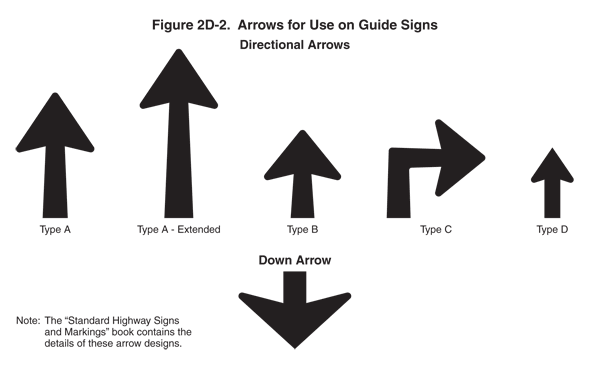
Standard:
02 On overhead signs where it is desirable to indicate a lane to be followed, a down arrow shall be positioned approximately over the center of the lane and shall point vertically downward toward the approximate center of that lane. Down arrows shall be used only on overhead guide signs that restrict the use of specific lanes to traffic bound for the destination(s) and/or route(s) indicated by these arrows. Down arrows shall not be used unless an arrow can be located over and pointed to the approximate center of each lane that can be used to reach the destination displayed on the sign.
03 If down arrows are used, having more than one down arrow pointing to the same lane on a single overhead sign (or on multiple signs on the same overhead sign structure) shall not be permitted.
04 Where a roadway is leaving the through lanes, a directional arrow shall point upward at an angle that approximates the alignment of the exit roadway.
Option:
05 Curved-stem arrows (see Figure 2D-8) that represent the intended driver paths to destinations involving left-turn movements may be used on guide signs on approaches to circular intersections.
Standard:
06 Curved-stem arrows shall not be used on any sign that is not associated with a circular intersection.
Guidance:
07 If curved-stem arrows are used, the principles set forth in Sections 2D.26 through 2D.29 should be followed.
08 The Type A directional arrow should be used on guide signs on freeways, expressways, and conventional roads to indicate the direction to a specific destination or group of destinations, except as otherwise provided in this Section and in Section 2E.19.
09 When a directional arrow in a vertical, upward-pointing orientation is placed to the side of a group of destinations to indicate a through movement, the Type A directional arrow should be used. When a directional arrow in a vertical, upward-pointing orientation is placed to the side of a single destination or under a destination or group of destinations, the Type B directional arrow should be used.
10 The Type B directional arrow should be used on guide signs on conventional roads when placed at any angle to the side of a single destination or when placed in a horizontal orientation to the side of a group of destinations.
11 The Type C advance turn directional arrow should be used on conventional road guide signs placed in advance of an intersection where a turn must be made to reach a posted destination or group of destinations.
12 The Type D directional arrow should be used primarily for sign applications other than guide signs, except as provided in Paragraph 15.
Option:
13 The Type A-Extended directional arrow may be used on guide signs where additional emphasis regarding the direction is needed relative to the amount of legend on the sign.
14 The Type C directional arrow may be used to the side of the legend of an overhead guide sign to accentuate a sharp turn exit maneuver from a mainline roadway (see Section 2E.36 for additional information regarding Exit Direction signs for low advisory ramp speeds).
15 On conventional roads on the approach to an intersection where the Combination Lane-Use/Destination overhead guide sign (see Section 2D.33) is not used, the Type C advance turn directional arrow may be used beneath the legend of an overhead guide sign to indicate the fact that a turn must be made from a mandatory movement lane over which the sign is placed to reach the destination or destinations displayed on the sign.
16 The Type D directional arrow may be used on post-mounted guide signs on conventional roads with lower operating speeds if the height of the text on the sign is 8 inches or less.
17 The directional and down arrows shown in Figure 2D-2 may be used on signs other than guide signs for the purposes of providing directional guidance and lane assignment.
Guidance:
18 Arrows used on guide signs to indicate the directions toward designated routes or destinations should be pointed at the appropriate angle to clearly convey the direction to be taken. A horizontally oriented directional arrow design should be used at right-angle intersections.
19 On a post-mounted guide sign, a directional arrow for a straight-through movement should point upward. Except as provided in Section 2D.46, for a turn, the arrow on a guide sign should point horizontally or at an upward angle that approximates the sharpness of the turn.
20 At an exit, an arrow should be placed at the side of the sign that will reinforce the movement of exiting traffic. The directional arrow design should be used.
Option:
21 Arrows may be placed below the principal sign legend or on the appropriate side of the legend.
22 On a post-mounted sign at an exit where placement of the arrow to the side of the legend farthest from the roadway would create an unusually wide sign that limits the road user's view of the arrow, the directional arrow may be placed at the bottom portion of the sign, centered under the legend.
Guidance:
23 The width across the arrowhead for the Types A, B, and C directional arrows should be between 1.5 and 1.75 times the height of the upper-case letters of the principal legend on the sign. The width across the arrowhead for the Type D directional arrow should be at least equal to the height of the upper-case letters of the principal legend on the sign. For down arrows used on overhead signs, the width across the arrowhead should be approximately two times the height of the upper-case letters of the principal legend on the sign.
24 Arrows used in Overhead Arrow-per-Lane and Diagrammatic guide signing, if used on conventional roads, except for signs on approaches to roundabouts, should follow the principles set forth in Section 2E.19.Arrows used in Diagrammatic guide signing on approaches to roundabouts should follow the principles set forth in Section 2D.38.
Support:
25 The "Standard Highway Signs and Markings" book (see Section 1A.11) contains design details and standardized sizes of the various arrows based on ranges of letter heights of principal legends.
Section 2D.09 Numbered Highway Systems
Support:
01 The purpose of numbering and signing highway systems is to identify routes and facilitate travel.
02 The Interstate and United States (U.S.) highway systems are numbered by the American Association of State Highway and Transportation Officials (AASHTO) upon recommendations of the State highway organizations because the respective States own these systems. State and county road systems are numbered by the appropriate authorities.
03 The basic policy for numbering the Interstate and U.S. highway systems is contained in the following Purpose and Policy statements published by AASHTO (see Page i for AASHTO's address):
- "Establishment and Development of United States Numbered Highways," and
- "Establishment of a Marking System of the Routes Comprising the National System of Interstate and Defense Highways."
Guidance:
04 The principles of these policies should be followed in establishing the highway systems described in Paragraph 2 and any other systems, with effective coordination between adjacent jurisdictions. Care should be taken to avoid the use of numbers or other designations that have been assigned to Interstate, U.S., or State routes in the same geographic area. Overlapping numbered routes should be kept to a minimum.
Standard:
05 Route systems shall be given preference in this order: Interstate, United States, State, and county. The preference shall be given by installing the highest-priority legend on the top or the left of the sign.
Support:
06 Section 2D.53 contains information regarding the signing of unnumbered highways to enhance route guidance and facilitate travel.
Section 2D.10 Route Signs and Auxiliary Signs
Standard:
01 All numbered highway routes shall be identified by route signs and auxiliary signs.
02 The signs for each system of numbered highways, which are distinctive in shape and color, shall be used only on that system and the approaches thereto.
Option:
03 Route signs and auxiliary signs may be proportionally enlarged where greater legibility is needed.
Support:
04 Route signs are typically mounted in assemblies with auxiliary signs.
05 Section 2D.55 contains information regarding the signing for National Scenic Byways.
06 Section 2H.07 contains information regarding the signing for Auto Tour Routes.
Section 2D.11 Design of Route Signs
Standard:
01 The "Standard Highway Signs and Markings" book (see Section 1A.11) shall be used for designing route signs. Other route sign designs shall be established by the authority having jurisdiction.
02 Interstate Route signs (see Figure 2D-3) shall consist of a cutout shield, with the route number in white letters on a blue background, the word INTERSTATE in white upper-case letters on a red background, and a white border. This sign shall be used on all Interstate routes and in connection with route sign assemblies on intersecting highways.
Figure 2D-3 Route Signs
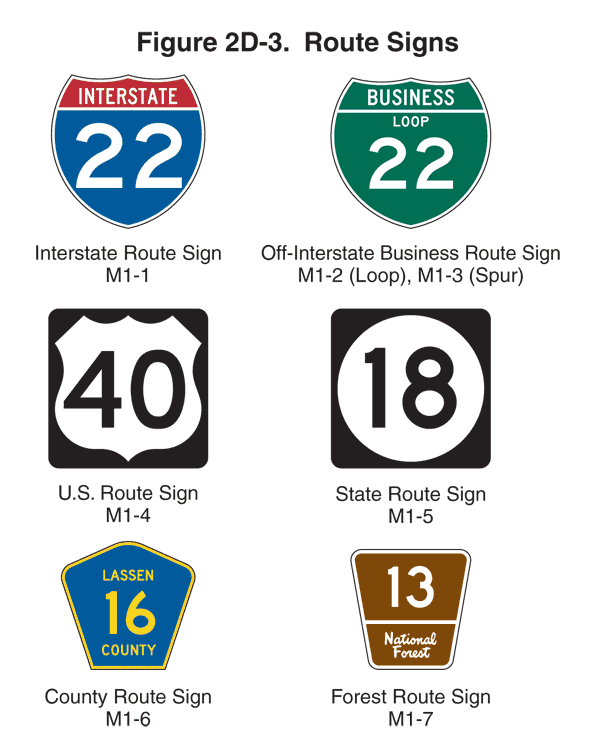
03 A 24 x 24-inch minimum sign size shall be used for Interstate route numbers with one or two digits, and a 30 x 24-inch minimum sign size shall be used for Interstate route numbers having three digits.
Option:
04 Interstate Route signs may contain the State name in white upper-case letters on a blue background.
Standard:
05 Off-Interstate Business Route signs (see Figure 2D-3) shall consist of a cutout shield carrying the number of the connecting Interstate route and the words BUSINESS and either LOOP or SPUR in upper-case letters. The legend and border shall be white on a green background, and the shield shall be the same shape and dimensions as the Interstate Route sign. In no instance shall the word INTERSTATE appear on the Off-Interstate Business Route sign.
Option:
06 The Off-Interstate Business Route sign may be used on a major highway that is not a part of the Interstate system, but one that serves the business area of a city from an interchange on the system.
07 When used on a green guide sign, a white square or rectangle may be placed behind the shield to improve contrast.
Standard:
08 U.S. Route signs (see Figure 2D-3) shall consist of black numerals on a white shield surrounded by a rectangular black background without a border. This sign shall be used on all U.S. routes and in connection with route sign assemblies on intersecting highways.
09 A 24 x 24-inch minimum sign size shall be used for U.S. route numbers with one or two digits, and a 30 x 24-inch minimum sign size shall be used for U.S. route numbers having three digits.
10 State Route signs shall be designed by the individual State highway agencies.
Guidance:
11 State Route signs (see Figure 2D-3) should be rectangular and should be approximately the same size as the U.S. Route sign. State Route signs should also be similar to the U.S. Route sign by containing approximately the same size black numerals on a white area surrounded by a rectangular black background without a border. The shape of the white area should be circular in the absence of any determination to the contrary by the individual State concerned.
12 Where U.S. or State Route signs are used as components of guide signs, only the distinctive shape of the shield itself and the route numerals within should be used. The rectangular background upon which the distinctive shape of the shield is mounted, such as the black area around the outside of the shields on the M1-4 and standard M1-5 signs, should not be included on the guide sign. Where U.S. or State Route signs are used as components of other signs of non-contrasting background colors, the rectangular background should be used to so that recognition of the distinctive shape of the shield can be maintained.
Standard:
13 If county road authorities elect to establish and identify a special system of important county roads, a statewide policy for such signing shall be established that includes a uniform numbering system to uniquely identify each route. The County Route (M1-6) sign (see Figure 2D-3) shall consist of a pentagon shape with a yellow county name and route number and border on a blue background. County Route signs displaying two digits or the equivalent (letter and numeral, or two letters) shall be a minimum size of 18 x 18 inches; those carrying three digits or the equivalent shall be a minimum size of 24 x 24 inches.
14 If a jurisdiction uses letters instead of numbers to identify routes, all references to numbered routes in this Chapter shall be interpreted to also include lettered routes.
Guidance:
15 If used with other route signs in common assemblies, the County Route sign should be of a size compatible with that of the other route signs.
Option:
16 When used on a green guide sign, a yellow square or rectangle may be placed behind the County Route sign to improve contrast.
Standard:
17 Route signs (see Figure 2D-3) for park and forest roads shall be designed with adequate distinctiveness and legibility and of a size compatible with other route signs used in common assemblies.
Section 2D.12 Design of Route Sign Auxiliaries
Standard:
01 Route sign auxiliaries carrying word legends, except the JCT sign, shall have a standard size of 24 x 12 inches. Those carrying arrow symbols, or the JCT sign, shall have a standard size of 21 x 15 inches. All route sign auxiliaries shall match the color combination of the route sign that they supplement.
Guidance:
02 With route signs of larger heights, auxiliary signs should be suitably enlarged, but not such that they exceed the width of the route sign.
03 The background, legend, and border of a route sign auxiliary should have the same colors as those of the route sign with which the auxiliary is mounted in a route sign assembly (see Section 2D.29). For a route sign design that uses multiple background colors, such as the Interstate route sign, the background color of the corresponding auxiliary should be that of the background area on which the route number is placed on the route sign.
Option:
04 A route sign and any auxiliary signs used with it may be combined on a single sign as a guide sign.
Guidance:
05 If a route sign and its auxiliary signs are combined to form a single guide sign, the background color of the sign should be green and the design should comply with the basic principles for the design of guide signs.
Standard:
06 If a route sign and its auxiliary signs are combined on a single sign with a green background, the auxiliary messages shall be white legends placed directly on the green background. Auxiliary signs shall not be mounted directly to a guide sign or other type of sign.
Support:
07 Chapter 2F contains information regarding auxiliary signs for toll highways.
Section 2D.13 Junction Auxiliary Sign (M2-1)
Standard:
01 The Junction (M2-1) auxiliary sign (see Figure 2D-4) shall carry the abbreviated legend JCT and shall be mounted at the top of an assembly (see Section 2D.30) directly above the route sign, the sign for an alternative route (see Section 2D.17) that is part of the route designation, or the Cardinal Direction auxiliary sign where access is available only to one direction of the intersected route. The minimum size of the Junction auxiliary sign shall be 21 x 15 inches for compatibility with auxiliary signs carrying arrow symbols.
Figure 2D-4 Route Sign Auxiliaries
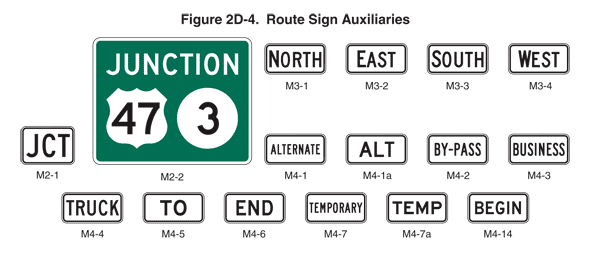
Section 2D.14 Combination Junction Sign (M2-2)
Option:
01 As an alternative to the standard Junction assembly where more than one route is to be intersected or joined, a rectangular guide sign may be used carrying the word JUNCTION above the route numbers.
Standard:
02 The Combination Junction (M2-2) sign (see Figure 2D-4) shall have a green background with white border and lettering for the word JUNCTION.
Guidance:
03 The Combination Junction sign should comply with the specific provisions of Section 2D.11 regarding the incorporation of the route signs as components of guide signs.
04 Although the size of the Combination Junction sign will depend on the number of routes involved, the numerals should be large enough for clear legibility and should be of a size comparable with those in the individual route signs.
Section 2D.15 Cardinal Direction Auxiliary Signs (M3-1 through M3-4)
Guidance:
01 Cardinal Direction auxiliary signs (see Figure 2D-4) carrying the legend NORTH, EAST, SOUTH, or WEST should be used to indicate the general direction of the entire route.
Standard:
02 To improve the readability and recognition of the cardinal directions, the first letter of the cardinal direction words shall be ten percent larger, rounded up to the nearest whole number size.
03 If used, the Cardinal Direction auxiliary sign shall be mounted directly above a route sign or, if used, an auxiliary sign for an alternative route.
Section 2D.16 Auxiliary Signs for Alternative Routes (M4 Series)
Option:
01 Auxiliary signs, carrying legends such as ALTERNATE, BY-PASS, BUSINESS, or TRUCK, may be used to indicate an alternate route of the same number between two points on that route.
Standard:
02 If used, the auxiliary signs for alternative routes shall be mounted directly above a route sign.
Section 2D.17 ALTERNATE Auxiliary Signs (M4-1, M4-1a)
Option:
01 The ALTERNATE (M4-1) or the ALT (M4-1a) auxiliary sign (see Figure 2D-4) may be used to indicate an officially designated alternate routing of a numbered route between two points on that route.
Standard:
02 If used, the ALTERNATE or ALT auxiliary sign shall be mounted directly above a route sign.
Guidance:
03 The shorter (time or distance) or better-constructed route should retain the regular route number, and the longer or worse-constructed route should be designated as the alternate route.
Section 2D.18 BY-PASS Auxiliary Sign (M4-2)
Option:
01 The BY-PASS (M4-2) auxiliary sign (see Figure 2D-4) may be used to designate a route that branches from the numbered route through a city, bypasses a part of the city or congested area, and rejoins the numbered route beyond the city.
Standard:
02 If used, the BY-PASS auxiliary sign shall be mounted directly above a route sign.
Section 2D.19 BUSINESS Auxiliary Sign (M4-3)
Option:
01 The BUSINESS (M4-3) auxiliary sign (see Figure 2D-4) may be used to designate an alternate route that branches from a numbered route, passes through the business portion of a city, and rejoins the numbered route beyond that area.
Standard:
02 If used, the BUSINESS auxiliary sign shall be mounted directly above a route sign.
Section 2D.20 TRUCK Auxiliary Sign (M4-4)
Option:
01 The TRUCK (M4-4) auxiliary sign (see Figure 2D-4) may be used to designate an alternate route that branches from a numbered route, when it is desirable to encourage or require commercial vehicles to use the alternate route.
Standard:
02 If used, the TRUCK auxiliary sign shall be mounted directly above a route sign.
Section 2D.21 TO Auxiliary Sign (M4-5)
Option:
01 The TO (M4-5) auxiliary sign (see Figure 2D-4) may be used to provide directional guidance to a particular road facility from other highways in the vicinity (see Section 2D.35).
Standard:
02 If used, the TO auxiliary sign shall be mounted directly above a route sign or an auxiliary sign for an alternative route. If a Cardinal Direction auxiliary sign is also included in the assembly, the TO auxiliary sign shall be mounted directly above the Cardinal Direction auxiliary sign.
Section 2D.22 END Auxiliary Sign (M4-6)
Guidance:
01 The END (M4-6) auxiliary sign (see Figure 2D-4) should be used where the route being traveled ends, usually at a junction with another route.
Standard:
02 If used, the END auxiliary sign shall be mounted either directly above a route sign or above a sign for an alternative route that is part of the designation of the route being terminated.
Section 2D.23 BEGIN Auxiliary Sign (M4-14)
Option:
01 The BEGIN (M4-14) auxiliary sign (see Figure 2D-4) may be used where a route begins, usually at a junction with another route.
Standard:
02 If used, the BEGIN auxiliary sign shall be mounted at the top of the first Confirming assembly (see Section 2D.34) for the route that is beginning.
Guidance:
03 If a BEGIN auxiliary sign is included in the first Confirming assembly, a Cardinal Direction auxiliary sign should also be included in the assembly.
Standard:
04 If a Cardinal Direction auxiliary sign is also included in the assembly, the BEGIN auxiliary sign shall be mounted directly above the Cardinal Direction auxiliary sign.
Section 2D.24 TEMPORARY Auxiliary Signs (M4-7, M4-7a)
Option:
01 The TEMPORARY (M4-7) or the TEMP (M4-7a) auxiliary sign (see Figure 2D-4) may be used for an interim period to designate a section of highway that is not planned as a permanent part of a numbered route, but that connects completed portions of that route.
Standard:
02 If used, the TEMPORARY or TEMP auxiliary sign shall be mounted directly above the route sign, above a Cardinal Direction sign, or above a sign for an alternate route that is a part of the route designation.
03 TEMPORARY or TEMP auxiliary signs shall be promptly removed when the temporary route is abandoned.
Section 2D.25 Temporary Detour and Auxiliary Signs
Support:
01 Chapter 6F contains information regarding Temporary Detour and Auxiliary signs.
Section 2D.26 Advance Turn Arrow Auxiliary Signs (M5-1, M5-2, and M5-3)
Standard:
01 If used, the Advance Turn Arrow auxiliary sign (see Figure 2D-5) shall be mounted directly below the route sign in Advance Route Turn assemblies, and displays a right or left arrow, the shaft of which is bent at a 90-degree angle (M5-1) or at a 45-degree angle (M5-2).
Figure 2D-5 Advance Turn and Directional Arrow Auxiliary Signs
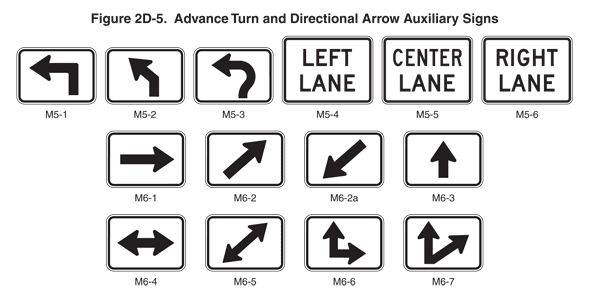
02 If used, the curved-stem Advance Turn Arrow auxiliary (M5-3) sign shall be used only on the approach to a circular intersection to depict a movement along the circulatory roadway around the central island and to the left, relative to the approach roadway and entry into the intersection.
Guidance:
03 If the M5-3 sign is used, then this arrow type should also be used consistently on any regulatory lane-use signs (see Chapter 2B), Destination signs (see Section 2D.37), and pavement markings (see Part 3) for a particular destination or movement.
Section 2D.27 Lane Designation Auxiliary Signs (M5-4, M5-5, and M5-6)
Option:
01 A Lane Designation (M5-4, M5-5, or M5-6) auxiliary sign (see Figure 2D-5) may be mounted directly below the route sign in an Advance Route Turn assembly on multi-lane roadways to allow road users to move into the appropriate lane prior to reaching the intersection or interchange.
Standard:
02 If used, the Lane Designation auxiliary signs shall be used only where the designated lane is a mandatory movement lane and shall be located adjacent to the full-width portion of the mandatory movement lane. The Lane Designation auxiliary signs shall not be installed adjacent to a through lane in advance of a lane that is being added or along the taper for a lane that is being added.
Section 2D.28 Directional Arrow Auxiliary Signs (M6 Series)
Standard:
01 If used, the Directional Arrow auxiliary sign (see Figure 2D-5) shall be mounted below the route sign and any other auxiliary signs in Directional assemblies (see Section 2D.32), and displays a single- or double-headed arrow pointing in the general direction that the route follows.
02 A Directional Arrow auxiliary sign that displays a double-headed arrow shall not be mounted in any Directional assembly in advance of or at a circular intersection.
Option:
03 The downward pointing diagonal arrow auxiliary (M6-2a) sign may be used in a Directional assembly at the far corner of an intersection to indicate the immediate entry point to a freeway or expressway entrance ramp (see Section 2D.46).
Standard:
04 The M6-2a sign shall not be used on the approach to or on the near side of an intersection, such as to designate an approach lane.
Section 2D.29 Route Sign Assemblies
Standard:
01 A Route Sign assembly shall consist of a route sign and auxiliary signs that further identify the route and indicate the direction. Route Sign assemblies shall be installed on all approaches to numbered routes that intersect with other numbered routes.
02 Where two or more routes follow the same section of highway, the route signs for Interstate, U.S., State, and county routes shall be mounted in that order from the left in horizontal arrangements and from the top in vertical arrangements. Subject to this order of precedence, route signs for lower-numbered routes shall be placed at the left or top.
03 Within groups of assemblies, information for routes intersecting from the left shall be mounted at the left in horizontal arrangements and at the top or center of vertical arrangements. Similarly, information for routes intersecting from the right shall be at the right or bottom, and for straight-through routes at the center in horizontal arrangements or top in vertical arrangements.
04 Route Sign assemblies shall be mounted in accordance with the general specifications for signs (Chapter 2A), with the lowest sign in the assembly at the height prescribed for single signs.
Guidance:
05 Assemblies for two or more routes, or for different directions on the same route, should be mounted in groups on a common support.
Option:
06 Route Sign assemblies may be installed on the approaches to numbered routes on unnumbered roads and streets that carry an appreciable amount of traffic destined for the numbered route.
07 The diagrammatic route guide sign format, such as the D1-4 and D1-5 signs shown in Figure 2D-8, may be used on approaches to roundabouts.
08 If engineering judgment indicates that groups of assemblies that include overlapping routes or multiple turns might be confusing, route signs or auxiliary signs may be omitted or combined, provided that clear directions are given to road users.
Support:
09 Figure 2D-6 shows typical placements of route signs.
Figure 2D-6 Illustration of Directional Assemblies and Other Route Signs (for One Direction of Travel Only)
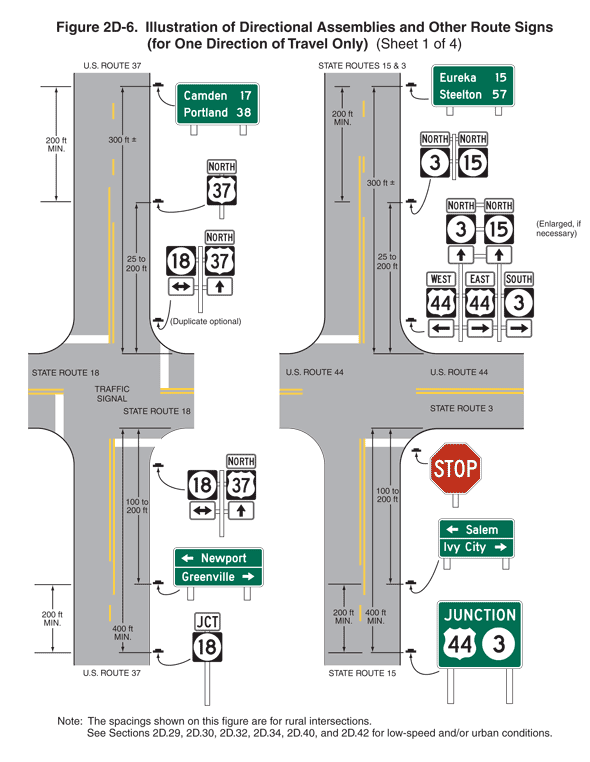
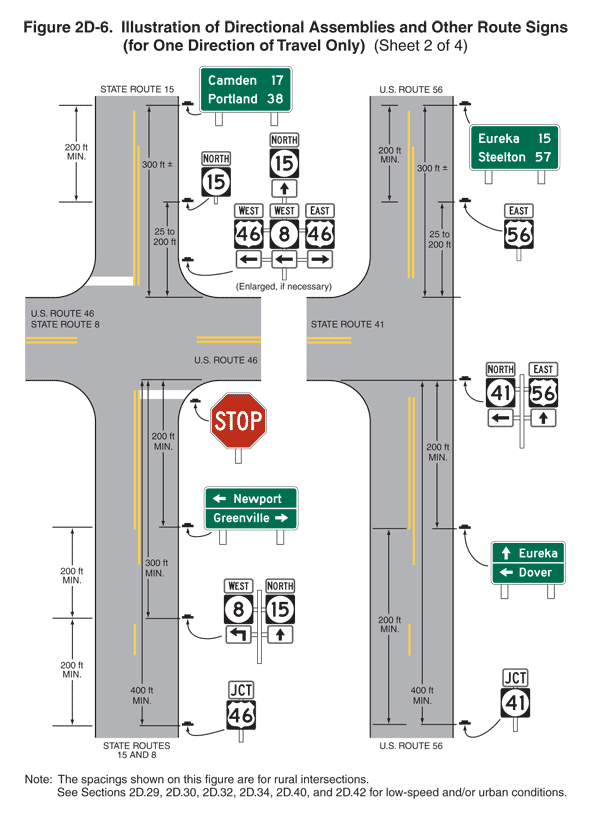
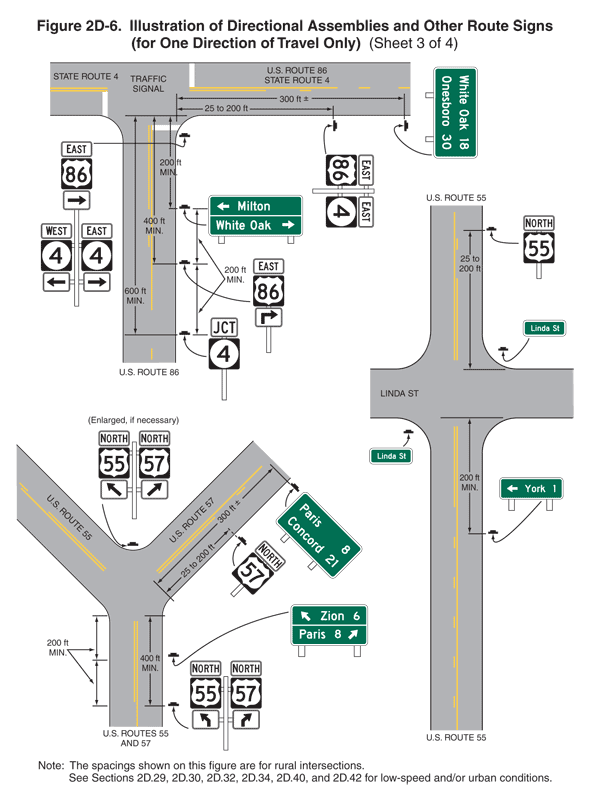
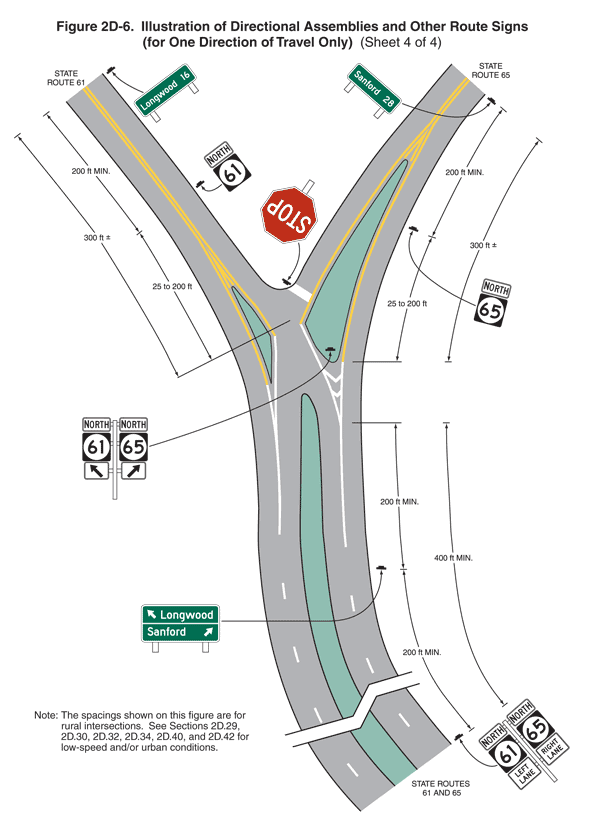
Section 2D.30 Junction Assembly
Standard:
01 A Junction assembly shall consist of a Junction auxiliary sign and a route sign. The route sign shall carry the number of the intersected or joined route.
02 The Junction assembly shall be installed in advance of every intersection where a numbered route is intersected or joined by another numbered route.
Guidance:
03 In urban areas, the Junction assembly should be installed in the block preceding the intersection. In urban areas where speeds are low, the Junction assembly should not be installed more than 300 feet in advance of the intersection.
04 In rural areas, the Junction assembly should be installed at least 400 feet in advance of the intersection. In rural areas, the minimum distance between a Junction assembly and either a Destination sign or an Advance Route Turn assembly should be 200 feet.
05 Where speeds are high, greater spacings should be used.
Option:
06 Where two or more routes are to be indicated, a single Junction auxiliary sign may be used for the assembly and all route signs grouped in a single mounting, or a Combination Junction (M2-2) sign (see Section 2D.14) may be used.
Section 2D.31 Advance Route Turn Assembly
Standard:
01 An Advance Route Turn assembly shall consist of a route sign, an Advance Turn Arrow or word message auxiliary sign, and a Cardinal Direction auxiliary sign, if needed. It shall be installed in advance of an intersection where a turn must be made to remain on the indicated route.
Option:
02 The Advance Route Turn assembly may be used to supplement the required Junction assembly in advance of intersecting routes.
Guidance:
03 Where a multiple-lane highway approaches an interchange or intersection with a numbered route, the Advance Route Turn assembly should be used to pre-position turning vehicles in the correct lanes from which to make their turn.
Option:
04 Lane Designation auxiliary signs (see Section 2D.27) may be used in Advance Route Turn Assemblies in place of the Advance Turn Arrow auxiliary signs where engineering judgment indicates that specific lane information associated with each route is needed and overhead signing is not practical and the designated lane is a mandatory movement lane. An assembly with the Lane Designation auxiliary signs may supplement or substitute for an assembly with Advance Turn Arrow auxiliary signs.
Guidance:
05 In low-speed areas, the Advance Route Turn assembly should be installed not less than 200 feet in advance of the turn. In high-speed areas, the Advance Route Turn assembly should be installed not less than 300 feet in advance of the turn. In rural areas, the minimum distance between an Advance Route Turn assembly and either a Destination sign or a Junction assembly should be 200 feet.
Standard:
06 An assembly that includes an Advance Turn Arrow auxiliary sign shall not be placed where there is an intersection between it and the designated turn.
Guidance:
07 Sufficient distance should be allowed between the assembly and any preceding intersection that could be mistaken for the indicated turn.
Section 2D.32 Directional Assembly
Standard:
01 A Directional assembly shall consist of a Cardinal Direction auxiliary sign, if needed; a route sign; and a Directional Arrow auxiliary sign. The various uses of Directional assemblies shall be as provided in Items A through D:
- Turn movements (indicated in advance by an Advance Route Turn assembly) shall be marked by a Directional assembly with a route sign displaying the number of the turning route and a single-headed arrow pointing in the direction of the turn.
- The beginning of a route (indicated in advance by a Junction assembly) shall be marked by a Directional assembly with a route sign displaying the number of that route and a single-headed arrow pointing in the direction of the route.
- An intersected route (indicated in advance by a Junction assembly) on a crossroad where the route is designated on both legs shall be designated by:
- Two Directional assemblies, each with a route sign displaying the number of the intersected route, a Cardinal Direction auxiliary sign, and a single-headed arrow pointing in the direction of movement on that route; or
- A Directional assembly with a route sign displaying the number of the intersected route and a double-headed arrow, pointing at appropriate angles to the left, right, or ahead.
- An intersected route (indicated in advance by a Junction assembly) on a side road or on a crossroad where the route is designated only on one of the legs shall be designated by a Directional assembly with a route sign displaying the number of the intersected route, a Cardinal Direction auxiliary sign, and a single-headed arrow pointing in the direction of movement on that route.
Guidance:
02 Straight-through movements should be indicated by a Directional assembly with a route sign displaying the number of the continuing route and a vertical arrow. A Directional assembly should not be used for a straight-through movement in the absence of other assemblies indicating right or left turns, as the Confirming assembly sign beyond the intersection normally provides adequate guidance.
03 Directional assemblies should be located on the near right corner of the intersection. At major intersections and at Y or offset intersections, additional Directional assemblies should be installed on the far right or left corner to confirm the near-side assemblies. When the near-corner position is not practical for Directional assemblies, the far right corner should be the preferred alternative, with oversized signs, if necessary, for legibility. Where unusual conditions exist, the location of a Directional assembly should be determined by engineering judgment with the goal being to provide the best possible combination of view and safety.
Support:
04 It is more important that guide signs be readable, and that the information and direction displayed thereon be readily understood, at the appropriate time and place than to be located with absolute uniformity.
05 Figure 2D-6 shows typical placements of Directional assemblies.
Section 2D.33 Combination Lane-Use/Destination Overhead Guide Sign (D15-1)
Option:
01 At complex intersection approaches involving multiple turn lanes and destinations, a Combination Lane-Use/Destination (D15-1) overhead guide sign that combines a lane-use regulatory sign with destination information such as a cardinal direction, a route number, a street name, and/or a place name may be used.
Support:
02 At such locations, the combined information on the D15-1 signs can be even more effective than separate lane-use and guide signs for conveying to unfamiliar drivers which lane or lanes to use for a particular destination.
03 Figure 2D-7 shows an example of a D15-1 sign that combines lane-use and route number information and an example of a D15-1 sign that combines lane-use and street name information.
Figure 2D-7 Destination and Distance Signs
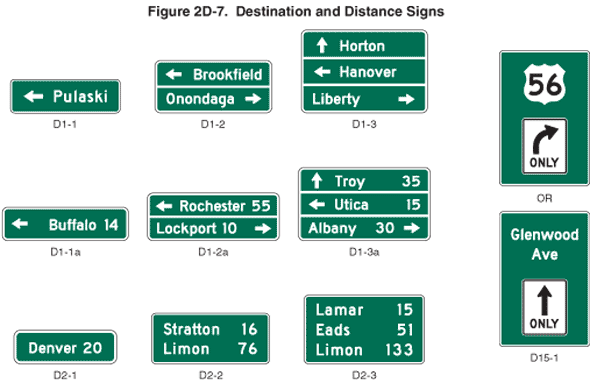
Standard:
04 The Combination Lane-Use/Destination (D15-1) overhead guide sign shall be used only where the designated lane is a mandatory movement lane. The D15-1 sign shall not be used for lanes with optional movements.
05 The D15-1 sign shall have a green background with a white border. As shown in Figure 2D-7, the lane-use sign (see Chapter 2B) shall be placed near the bottom of the sign and the destination information shall be placed near the top of the sign. The D15-1 sign shall be located approximately over the center of the lane to which it applies.
Section 2D.34 Confirming or Reassurance Assemblies
Standard:
01 If used, Confirming or Reassurance assemblies shall consist of a Cardinal Direction auxiliary sign and a route sign. Where the Confirming or Reassurance assembly is for an alternative route, the appropriate auxiliary sign for an alternative route (see Section 2D.16) shall also be included in the assembly.
Guidance:
02 A Confirming assembly should be installed just beyond intersections of numbered routes. It should be placed 25 to 200 feet beyond the far shoulder or curb line of the intersected highway.
03 If used, Reassurance assemblies should be installed between intersections in urban areas as needed, and beyond the built-up area of any incorporated city or town.
04 Route signs for either confirming or reassurance purposes should be spaced at such intervals as necessary to keep road users informed of their routes.
Section 2D.35 Trailblazer Assembly
Support:
01 Trailblazer assemblies provide directional guidance to a particular road facility from other highways in the vicinity. This guidance is accomplished by installing Trailblazer assemblies at strategic locations to indicate the direction to the nearest or most convenient point of access. The use of the word TO indicates that the road or street where the sign is posted is not a part of the indicated route, and that a road user is merely being directed progressively to the route.
Standard:
02 A Trailblazer assembly shall consist of a TO auxiliary sign, a route sign for a numbered or named highway (see Section 2D.53) or an Auto Tour Route sign (see Section 2H.07), and a single-headed Directional Arrow auxiliary sign pointing in the direction leading to the route. Where the Trailblazer assembly is for an alternative route, the appropriate auxiliary sign for an alternative route (see Section 2D.16) shall also be included in the assembly.
Option:
03 A Cardinal Direction auxiliary sign may be used with a Trailblazer assembly.
Guidance:
04 The TO auxiliary sign, Cardinal Direction auxiliary sign, and Directional Arrow auxiliary sign should be of the standard size provided for auxiliary signs of their respective type. The route sign should be the size provided in Section 2D.11.
Option:
05 Trailblazer assemblies may be installed with other Route Sign assemblies, or alone, in the immediate vicinity of the designated facilities.
Section 2D.36 Destination and Distance Signs
Support:
01 In addition to guidance by route numbers, it is desirable to supply the road user information concerning the destinations that can be reached by way of numbered or unnumbered routes. This is done by means of Destination signs and Distance signs.
Option:
02 Route shields and cardinal directions may be included on the Destination sign with the destinations and arrows.
Guidance:
03 If Route shields and cardinal directions are included on a Destination sign, the height of the route shields should be at least two times the height of the upper-case letters of the principal legend and not less than 18 inches, and the cardinal directions should be in all upper-case letters that are at least the minimum height specified for these signs.
Section 2D.37 Destination Signs (D1 Series)
Standard:
01 Except on approaches to interchanges (see Section 2D.45), the Destination (D1-1 through D1-3) sign (see Figure 2D-7), if used, shall be a horizontal rectangle displaying the name of a city, town, village, or other traffic generator, and a directional arrow.
Option:
02 The distance (see Section 2D.41) to the place named may also be displayed on the Destination (D1-1a through D1-3a) sign (see Figure 2D-7). If several destinations are to be displayed at a single point, the several names may be placed on a single sign with an arrow (and the distance, if desired) for each name. If more than one destination lies in the same direction, a single arrow may be used for such a group of destinations.
Guidance:
03 Adequate separation should be made between any destinations or group of destinations in one direction and those in other directions by suitable design of the arrow, spacing of lines of legend, heavy lines entirely across the sign, or separate signs.
Support:
04 Separation of destinations by direction by the use of a horizontal separator line can enhance the readability of a Destination sign by relating an arrow and its corresponding destination(s) and by eliminating the need for multiple arrows that point in the same direction and excessive space between lines of legend.
Standard:
05 Except as otherwise provided in this Manual, an arrow pointing to the right shall be at the extreme right of the sign, and an arrow pointing left or up shall be at the extreme left. The distance numerals, if used, shall be placed to the right of the destination names.
Option:
06 An arrow pointing up may be placed at the extreme right of the sign when the sign is mounted to the left of the traffic to which it applies.
Guidance:
07 Unless a sloping arrow will convey a clearer indication of the direction to be followed, the directional arrows should be horizontal or vertical.
08 If several individual name signs are assembled into a group, all signs in the assembly should be of the same horizontal width.
09 Destination signs should be used:
- At the intersections of U.S. or State numbered routes with Interstate, U.S., or State numbered routes; and
- At points where they serve to direct traffic from U.S. or State numbered routes to the business section of towns, or to other destinations reached by unnumbered routes.
Standard:
10 Where a total of three or less destinations are provided on the Advance Guide (see Section 2E.33) and Supplemental Guide (see Section 2E.35) signs, no more than three destination names shall be used on a Destination sign. Where four destinations are provided by the Advance Guide and Supplemental Guide signs, no more than four destination names shall be used on a Destination sign.
Guidance:
11 If space permits, four destinations should be displayed as two separate signs at two separate locations.
Option:
12 Where space does not permit, or where all four destinations are in one direction, a single sign may be used. Where a single sign is used and all destinations are in the same direction, the arrow may be placed below the destinations for the purpose of enhancing the conspicuity of the arrow.
Standard:
13 Where a single four-name sign assembly is used, a heavy line entirely across the sign or separate signs shall be used to separate destinations by direction.
Guidance:
14 The closest destination lying straight ahead should be at the top of the sign or assembly, and below it the closest destinations to the left and to the right, in that order. The destination displayed for each direction should ordinarily be the next county seat or the next principal city, rather than a more distant destination. In the case of overlapping routes, only one destination should be displayed in each direction for each route.
Standard:
15 If more than one destination is displayed in the same direction, the name of a nearer destination shall be displayed above the name of a destination that is further away.
Section 2D.38 Destination Signs at Circular Intersections
Standard:
01 Destination signs that are used at circular intersections shall comply with the provisions of Section 2D.37, except as provided in this Section.
Option:
02 Exit destination (D1-1d, D1-1e) signs (see Figure 2D-8) with diagonal upward-pointing arrows or Directional assemblies (see Section 2D.32) may be used to designate a particular exit from a circular intersection.
Figure 2D-8 Destination Signs for Roundabouts

03 Exit destination (D1-2d, D1-3d) signs (see Figure 2D-8) with curved-stem arrows may be used on approaches to circular intersections to represent the left-turn movements.
04 Curved-stem arrows on circular intersection destination signs may point in diagonal directions to depict the location of an exit relative to the approach roadway and entry into the intersection.
05 Exit destination (D1-4 or D1-5) signs (see Figure 2D-8) with a diagram of the circular intersection may be used on approaches to circular intersections.
Guidance:
06 If curved-stem arrows are used on destination signs, then this arrow type should also be used consistently on any regulatory lane-use signs (see Chapter 2B), Directional assemblies (see Section 2D.32), and pavement markings (see Part 3) for a particular destination or movement.
Support:
07 Figure 2D-9 illustrates two examples of guide signing for circular intersections.
Figure 2D-9 Examples of Guide Signs for Roundabouts
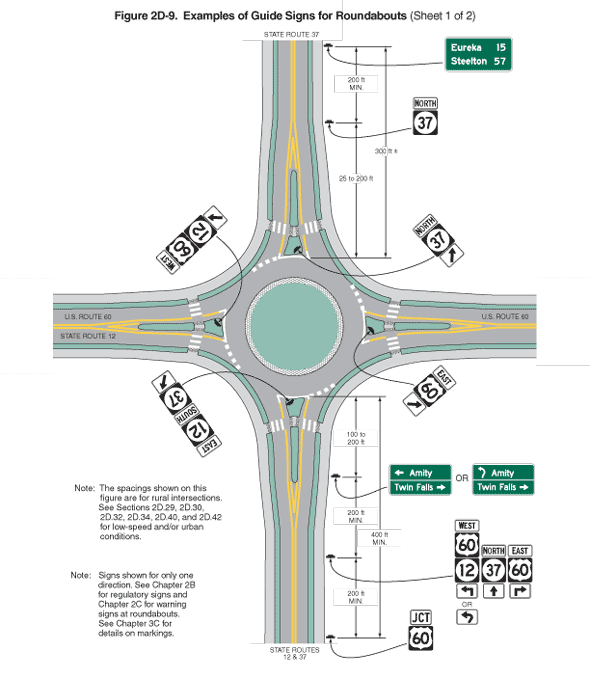
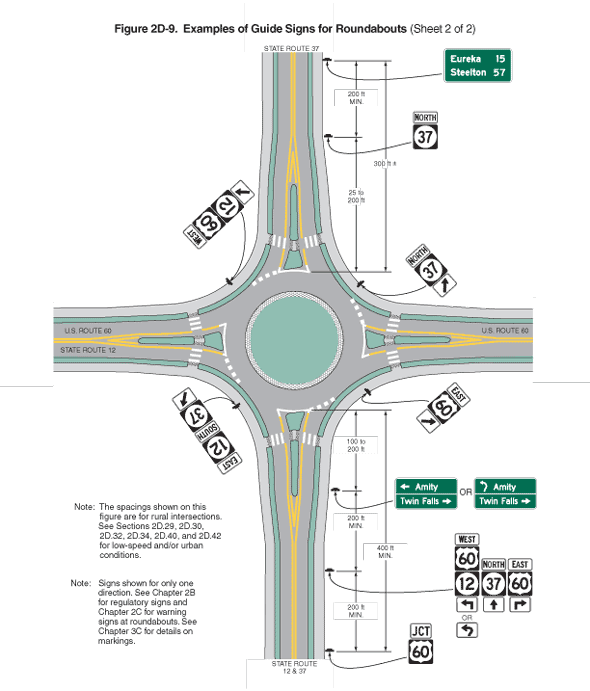
08 Diagrammatic guide signs might be preferable where space is available and where the geometry of the circular intersection is non-typical, such as where more than four legs are present or where the legs are not at approximately 90-degree angles to each other.
Standard:
09 If used, diagrammatic guide signs for circular intersections shall not depict the number of lanes within the intersection circulatory roadway, or on its approaches or exits, through the use of lane lines, multiple arrow shafts for the same movement, or other methods.
Support:
10 Chapter 2B contains information regarding regulatory signs at circular intersections, Chapter 2C contains information regarding warning signs at circular intersections, and Chapter 3C contains information regarding pavement markings at circular intersections.
Section 2D.39 Destination Signs at Jughandles
Standard:
01 Destination signs that are used at jughandles shall comply with the provisions of Section 2D.37, except as provided in this Section.
Option:
02 If engineering judgment indicates that standard destination signs alone are insufficient to direct road users to their destinations at a jughandle, a diagrammatic guide sign depicting the appropriate geometry may be used to supplement the normal destination signs.
Support:
03 Section 2B.27 contains information regarding regulatory signs for jughandle turns. Figure 2B-9 shows examples of regulatory and destination guide signing for various types of jughandle turns.
Section 2D.40 Location of Destination Signs
Guidance:
01 When used in high-speed areas, Destination signs should be located 200 feet or more in advance of the intersection, and following any Junction or Advance Route Turn assemblies that might be required. In rural areas, the minimum distance between a Destination sign and either an Advance Route Turn assembly or a Junction assembly should be 200 feet.
Option:
02 In urban areas, shorter advance distances may be used.
03 Because the Destination sign is of lesser importance than the Junction, Advance Route Turn, or Directional assemblies, the Destination sign may be eliminated when sign spacing is critical.
Support:
04 Figure 2D-6 shows typical placements of Destination signs.
Section 2D.41 Distance Signs (D2 Series)
Standard:
01 If used, the Distance (D2-1 through D2-3) sign (see Figure 2D-7) shall be a horizontal rectangle of a size appropriate for the required legend, carrying the names of no more than three cities, towns, junctions, or other traffic generators, and the distance (to the nearest mile) to those places.
02 The distance numerals shall be placed to the right of the destination names as shown in Figure 2D-7.
Guidance:
03 The distance displayed should be selected on a case-by-case basis by the jurisdiction that owns the road or by statewide policy. A well-defined central area or central business district should be used where one exists. In other cases, the layout of the community should be considered in relation to the highway being signed and the decision based on where it appears that most drivers would feel that they are in the center of the community in question.
04 The top name on the Distance sign should be that of the next place on the route having a post office or a railroad station, a route number or name of an intersected highway, or any other significant geographical identity. The bottom name on the sign should be that of the next major destination or control city. If three destinations are displayed, the middle line should be used to indicate communities of general interest along the route or important route junctions.
Option:
05 The choice of names for the middle line may be varied on successive Distance signs to give road users additional information concerning communities served by the route.
Guidance:
06 The control city should remain the same on all successive Distance signs throughout the length of the route until that city is reached.
Option:
07 If more than one distant point may properly be designated, such as where the route divides at some distance ahead to serve two destinations of similar importance, and if these two destinations cannot appear on the same sign, the two names may be alternated on successive signs.
08 On a route continuing into another State, destinations in the adjacent State may be displayed.
Section 2D.42 Location of Distance Signs
Guidance:
01 If used, Distance signs should be installed on important routes leaving municipalities and just beyond intersections of numbered routes in rural areas. If used, they should be placed just outside the municipal limits or at the edge of the built-up area if it extends beyond the limits.
02 Where overlapping routes separate a short distance from the municipal limits, the Distance sign at the municipal limits should be omitted. The Distance sign should be installed approximately 300 feet beyond the separation of the two routes.
03 Where, just outside of an incorporated municipality, two routes are concurrent and continue concurrently to the next incorporated municipality, the top name on the Distance sign should be that of the place where the routes separate; the bottom name should be that of the city to which the greater part of the through traffic is destined.
Support:
04 Figure 2D-6 shows typical placements of Distance signs.
Section 2D.43 Street Name Signs (D3-1 or D3-1a)
Guidance:
01 Street Name (D3-1 or D3-1a) signs (see Figure 2D-10) should be installed in urban areas at all street intersections regardless of other route signs that might be present and should be installed in rural areas to identify important roads that are not otherwise signed.
Figure 2D-10 Street Name and Parking Signs

Option:
02 For streets that are part of a U.S., State, or county numbered route, a D3-1a Street Name sign (see Figure 2D-10) that incorporates a route shield may be used to assist road users who might not otherwise be able to associate the name of the street with the route number.
Standard:
03 The lettering for names of streets and highways on Street Name signs shall be composed of a combination of lower-case letters with initial upper-case letters (see Section 2A.13).
Guidance:
04 Lettering on post-mounted Street Name signs should be composed of initial upper-case letters at least 6 inches in height and lower-case letters at least 4.5 inches in height.
05 On multi-lane streets with speed limits greater than 40 mph, the lettering on post-mounted Street Name signs should be composed of initial upper-case letters at least 8 inches in height and lower-case letters at least 6 inches in height.
Option:
06 For local roads with speed limits of 25 mph or less, the lettering on post-mounted Street Name signs may be composed of initial upper-case letters at least 4 inches in height and lower-case letters at least 3 inches in height.
Guidance:
07 If overhead Street Name signs are used, the lettering should be composed of initial upper-case letters at least 12 inches in height and lower-case letters at least 9 inches in height.
Support:
08 The recommended minimum letter heights for Street Name signs are summarized in Table 2D-2.
| Type of Mounting | Type of Street or Highway | Speed Limit | Recommended Minimum Letter Height |
|
|---|---|---|---|---|
| Initial Upper-Case | Lower-Case | |||
| Overhead | All types | All speed limits | 12 inches | 9 inches |
| Post-mounted | Multi-lane | More than 40 mph | 8 inches | 6 inches |
| Post-mounted | Multi-lane | 40 mph or less | 6 inches | 4.5 inches |
| Post-mounted | 2-lane | All speed limits | 6 inches* | 4.5 inches* |
* On local two-lane streets with speed limits of 25 mph or less, 4-inch initial upper-case letters with 3-inch lower-case letters may be used.
Option:
09 Supplementary lettering to indicate the type of street (such as Street, Avenue, or Road) or the section of the city (such as NW) on the D3-1 and D3-1a signs may be in smaller lettering, composed of initial upper-case letters at least 3 inches in height and lower-case letters at least 2.25 inches in height. Conventional abbreviations (see Section 1A.15) may be used except for the street name itself.
10 A pictograph (see definition in Section 1A.13) may be used on a D3-1 sign.
Standard:
11 Pictographs shall not be displayed on D3-1a or Advance Street Name (D3-2) signs (see Section 2D.44).
12 If a pictograph is used on a D3-1 sign, the height and width of the pictograph shall not exceed the upper-case letter height of the principal legend of the sign.
Guidance:
13 The pictograph should be positioned to the left of the street name.
Standard:
14 The Street Name sign shall be retroreflective or illuminated to show the same shape and similar color both day and night. The color of the legend (and border, if used) shall contrast with the background color of the sign.
Option:
15 The border may be omitted from a Street Name sign.
16 An alternative background color other than the normal guide sign color of green may be used for Street Name (D3-1 or D3-1a) signs where the highway agency determines this is necessary to assist road users in determining jurisdictional authority for roads.
Standard:
17 Alternative background colors shall not be used for Advance Street Name (D3-2) signs (see Section 2D.44).
18 The only acceptable alternative background colors for Street Name (D3-1 or D3-1a) signs shall be blue, brown, or white. Regardless of whether green, blue, or brown is used as the background color for Street Name (D3-1 or D3-1a) signs, the legend (and border, if used) shall be white. For Street Name signs that use a white background, the legend (and border, if used) shall be black.
Guidance:
19 An alternative background color for Street Name signs, if used, should be applied to the Street Name (D3-1 or D3-1a) signs on all roadways under the jurisdiction of a particular highway agency.
20 In business or commercial areas and on principal arterials, Street Name signs should be placed at least on diagonally opposite corners. In residential areas, at least one Street Name sign should be mounted at each intersection. Signs naming both streets should be installed at each intersection. They should be mounted with their faces parallel to the streets they name.
Option:
21 To optimize visibility, Street Name signs may be mounted overhead. Street Name signs may also be placed above a regulatory or STOP or YIELD sign with no required vertical separation.
Guidance:
22 In urban or suburban areas, especially where Advance Street Name signs for signalized and other major intersections are not used, the use of overhead Street Name signs should be strongly considered.
Option:
23 At intersection crossroads where the same road has two different street names for each direction of travel, both street names may be displayed on the same sign along with directional arrows.
Support:
24 Information regarding the use of street names on supplemental plaques for use with intersection-related warning signs is contained in Section 2C.58.
Section 2D.44 Advance Street Name Signs (D3-2)
Support:
01 Advance Street Name (D3-2) signs (see Figure 2D-10) identify an upcoming intersection. Although this is often the next intersection, it could also be several intersections away in cases where the next signalized intersection is referenced.
Standard:
02 Advance Street Name (D3-2) signs, if used, shall supplement rather than be used instead of the Street Name (D3-1) signs at the intersection.
Option:
03 Advance Street Name (D3-2) signs may be installed in advance of signalized or unsignalized intersections to provide road users with advance information to identify the name(s) of the next intersecting street to prepare for crossing traffic and to facilitate timely deceleration and/or lane changing in preparation for a turn.
Guidance:
04 On arterial highways in rural areas, Advance Street Name signs should be used in advance of all signalized intersections and in advance of all intersections with exclusive turn lanes.
05 In urban areas, Advance Street Name signs should be used in advance of all signalized intersections on major arterial streets, except where signalized intersections are so closely spaced that advance placement of the signs is impractical.
06 The heights of the letters on Advance Street Name signs should be the same as those used for Street Name signs (see Section 2D.43).
Standard:
07 If used, Advance Street Name signs shall have a white legend and border on a green background.
08 If used, Advance Street Name signs shall provide the name(s) of the intersecting street(s) on the top line(s) of the legend and the distance to the intersecting streets or messages such as NEXT SIGNAL, NEXT INTERSECTION, NEXT ROUNDABOUT, or directional arrow(s) on the bottom line of the legend.
09 Pictographs shall not be displayed on Advance Street Name signs.
Option:
10 Directional arrow(s) may be placed to the right or left of the street name or message such as NEXT SIGNAL, as appropriate, rather than on the bottom line of the legend. Curved-stem arrows may be used on Advance Street Name signs on approaches to circular intersections.
11 For intersecting crossroads where the same road has a different street name for each direction of travel, the different street names may be displayed on the same Advance Street Name sign along with directional arrows.
12 In advance of two closely-spaced intersections where it is not practical to install separate Advance Street Name signs, the Advance Street Name sign may include the street names for both intersections along with appropriate supplemental legends for both street names, such as NEXT INTERSECTION, 2ND INTERSECTION, or NEXT LEFT and NEXT RIGHT, or directional arrows.
Guidance:
13 If two street names are used on the Advance Street Name sign, the street names should be displayed in the following order:
- For a single intersection where the same road has a different street name for each direction of travel, the name of the street to the left should be displayed above the name of the street to the right; or
- For two closely-spaced intersections, the name of the first street encountered should be displayed above the name of the second street encountered, and the arrow associated with the second street encountered should be an advance arrow, such as the arrow shown on the W16-6P arrow plaque (see Figure 2C-12).
Option:
14 An Advance Street Name (W16-8P or W16-8aP) plaque (see Section 2C.58) with black legend on a yellow background, installed supplemental to an Intersection (W2 series) or Advance Traffic Control (W3 series) warning sign may be used instead of an Advance Street Name guide sign.
Section 2D.45 Signing on Conventional Roads on Approaches to Interchanges
Support:
01 Because there are a number of different ramp configurations that are commonly used at interchanges with conventional roads, drivers on the conventional road cannot reliably predict whether they will be required to turn left or right in order to enter the correct ramp to access the freeway or expressway in the desired direction of travel. Consistently applied signing for conventional road approaches to freeway or expressway interchanges is highly desirable.
Standard:
02 On multi-lane conventional roads approaching an interchange, guide signs shall be provided to identify which direction of turn is to be made and/or which specific lane to use for ramp access to each direction of the freeway or expressway.
Guidance:
03 The signing of conventional roads with one lane of traffic approaching an interchange should consist of a sequence containing the following signs (see Figure 2D-11):
Figure 2D-11 Example of Interchange Crossroad Signing for a One-Lane Approach
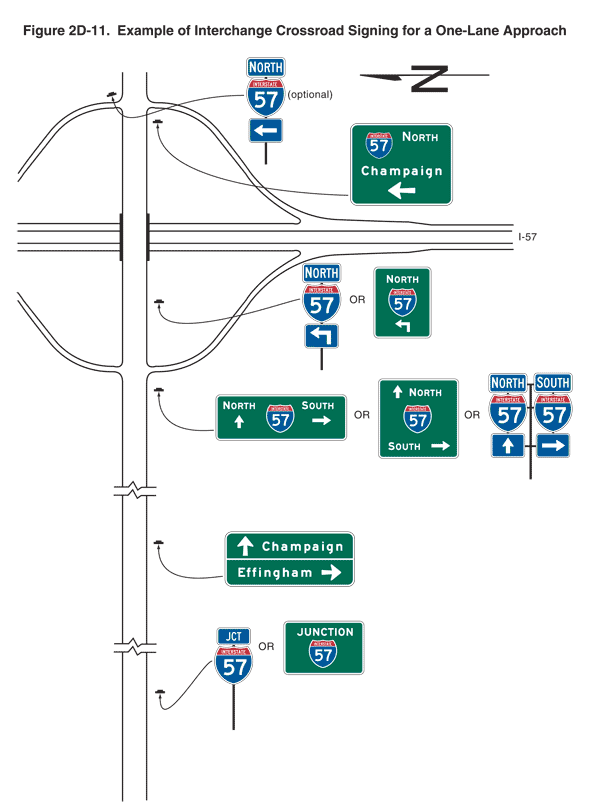
- Junction Assembly
- Destination sign
- Directional Assembly or Entrance Direction sign for the first ramp
- Advance Route Turn Assembly or Advance Entrance Direction sign with an advance turn arrow
- Directional Assembly or Entrance Direction sign for the second ramp
Standard:
04 If used, the Entrance Direction sign shall consist of a white legend and border on a green background. It shall contain the freeway or expressway route shield(s), cardinal direction, and directional arrow(s).
Option:
05 The Entrance Direction sign may contain a destination(s) and/or an action message such as NEXT RIGHT.
06 At minor interchanges, the following sequence of signs may be used (see Figure 2D-12):
Figure 2D-12 Example of Minor Interchange Crossroad Signing
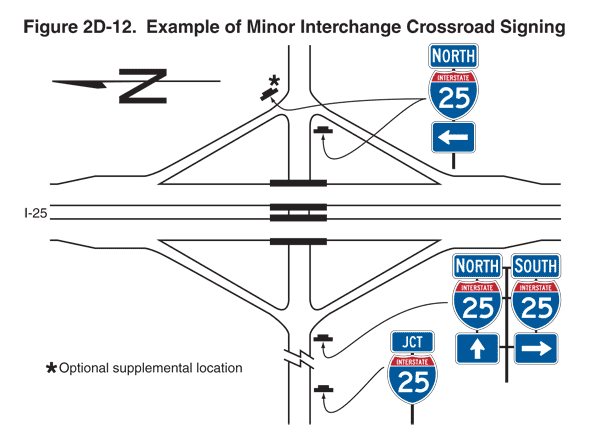
- Junction Assembly
- Directional Assembly for the first ramp
- Directional Assembly for the second ramp
Guidance:
07 On multi-lane conventional roads approaching an interchange, the sign sequence should contain the following signs (see Figures 2D-13 through 2D-15):
Figure 2D-13 Examples of Multi-Lane Crossroad Signing for a Diamond Interchange

Figure 2D-14 Examples of Multi-Lane Crossroad Signing for a Partial Cloverleaf Interchange
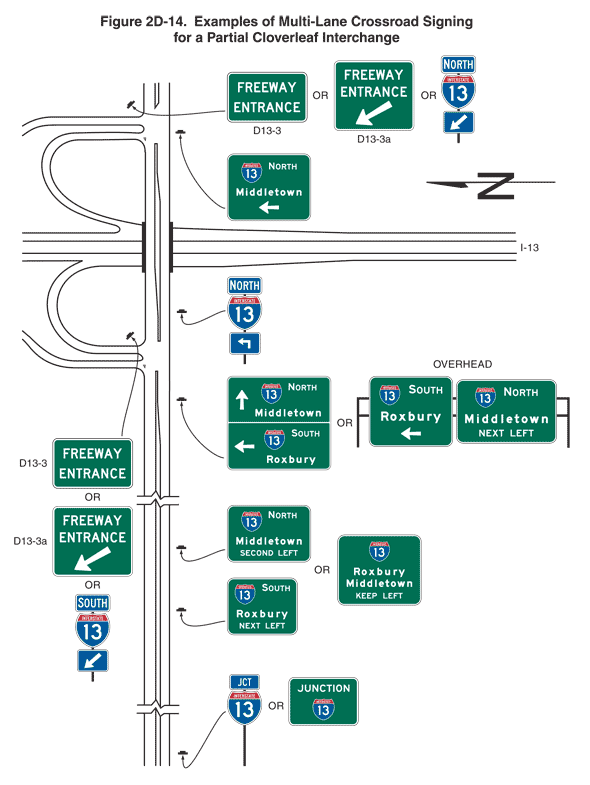
Figure 2D-15 Examples of Multi-Lane Crossroad Signing for a Cloverleaf Interchange

- Junction Assembly
- Advance Entrance Direction sign(s) for both directions (if applicable) of travel on the freeway or expressway
- Entrance Direction sign for first ramp
- Advance Turn Assembly
- Entrance Direction sign for the second ramp
Support:
08 Advance Entrance Direction signs are used to direct road users to the appropriate lane(s).
Standard:
09 The Advance Entrance Direction sign shall consist of a white legend and border on a green background. It shall contain the freeway or expressway route shield(s) and cardinal direction(s).
Option:
10 The Advance Entrance Direction sign may have destinations, directional arrows, and/or an action message such as KEEP LEFT, NEXT LEFT, or SECOND RIGHT. Signs in this sequence may be mounted overhead to improve visibility as shown in Figures 2D-13 through 2D-15.
Support:
11 A post-mounted Advance Entrance Direction diagrammatic guide sign (see Figure 2D-16), within the sequence of approach guide signing described in Paragraphs 3, 6, and 7, might be helpful in depicting the location of a freeway or expressway entrance ramp that is in close proximity to an intervening intersection on the same side of the approach roadway and where signing for only the ramp might cause confusion to road users.
Figure 2D-16 Example of Crossroad Signing for an Entrance Ramp with a Nearby Frontage Road

Standard:
12 If used, the post-mounted Advance Entrance Direction diagrammatic guide sign shall display only the two successive turns from the same side of the roadway, one of which shall be the entrance ramp. The post-mounted Advance Entrance Direction sign shall depict only the successive turns and shall not depict lane use with lane lines, multiple arrow shafts for the approach roadway, action messages, or other representations.
Support:
13 Section 2D.46 contains information regarding the use of a Directional assembly or a FREEWAY ENTRANCE sign to mark the entrance to a freeway or expressway at the far corner of an intersection.
Section 2D.46 Freeway Entrance Signs (D13-3 and D13-3a)
Option:
01 FREEWAY ENTRANCE (D13-3) signs or FREEWAY ENTRANCE with downward pointing diagonal arrow (D13-3a) signs (see Figure 2D-14) may be used on entrance ramps near the crossroad to inform road users of the freeway or expressway entrance, as appropriate.
02 The D13-3 and D13-3a signs may display an alternate legend in place of FREEWAY, such as EXPRESSWAY or PARKWAY, as appropriate, or may display the name of an unnumbered highway.
03 A Directional assembly (see Section 2D.32) with a downward pointing diagonal arrow auxiliary (M6-2a) sign (see Section 2D.28) may be used at the far left-hand corner of an intersection with a freeway or expressway entrance ramp as an alternative to the D13-3a sign, facing left-turning traffic on the conventional road approach to indicate the immediate point of entry to the freeway or expressway and distinguish the entrance ramp from an adjoining exit ramp terminal at the same intersection with the conventional road (see Figure 2D-14). A similar Directional assembly may be used at the far right-hand corner of an intersection with a freeway or expressway entrance ramp where the entrance ramp and a crossroad or side road follow one another in close succession on the conventional road approach and the point of entry to the freeway or expressway might be difficult for the road user to distinguish from the crossroad or side road on the conventional road approach (see Figure 2D-14).
Support:
04 Section 2B.41 contains information regarding the use of regulatory signs to deter wrong-way movements at intersections of freeway or expressway ramps with conventional roads, and in the area where entrance ramps intersect with the mainline lanes.
Section 2D.47 Parking Area Guide Sign (D4-1)
Option:
01 The Parking Area (D4-1) guide sign (see Figure 2D-10) may be used to show the direction to a nearby public parking area or parking facility.
Standard:
02 If used, the Parking Area (D4-1) guide sign shall be a horizontal rectangle with a standard size of 30 x 24 inches, or with a smaller size of 18 x 15 inches for minor, low-speed streets. It shall carry the word PARKING, with the letter P five times the height of the remaining letters, and a directional arrow. The legend and border shall be green on a retroreflectorized white background.
Guidance:
03 If used, the Parking Area guide sign should be installed on major thoroughfares at the nearest point of access to the parking facility and where it can advise drivers of a place to park. The sign should not be used more than four blocks from the parking area.
Section 2D.48 PARK - RIDE Sign (D4-2)
Option:
01 PARK - RIDE (D4-2) signs (see Figure 2D-10) may be used to direct road users to park - ride facilities.
Standard:
02 The signs shall contain the word message PARK - RIDE and direction information (arrow or word message).
Option:
03 PARK - RIDE signs may contain the local transit pictograph and/or carpool symbol on the sign.
Standard:
04 If used, the local transit pictograph and/or carpool symbol shall be located in the top part of the sign above the message PARK - RIDE. In no case shall the vertical dimension of the local transit pictograph and/or carpool symbol exceed 18 inches.
Guidance:
05 If the function of the parking facility is to provide parking for persons using public transportation, the local transit pictograph should be used on the guide sign. If the function of the parking facility is to serve carpool riders, the carpool symbol should be used on the guide sign. If the parking facility serves both functions, both the pictograph and carpool symbol should be used.
Standard:
06 These signs shall have a retroreflective white legend and border on a rectangular green background. The carpool symbol shall be as shown for the D4-2 sign. The color of the local transit pictograph shall be selected by the local transit authority.
Option:
07 To increase the target value and contrast of the local transit pictograph, and to allow the local transit pictograph to retain its distinctive color and shape, the pictograph may be included within a white border or placed on a white background.
Section 2D.49 Weigh Station Signing (D8 Series)
Support:
01 The general concept for Weigh Station signing is similar to Rest Area signing (see Section 2I.05) because in both cases traffic using either area remains within the right-of-way.
Standard:
02 The standard installation for Weigh Station signing shall include three basic signs:
- Advance sign (D8-1),
- Exit Direction sign (D8-2), and
- Exit Gore sign (D8-3).
Support:
03 Example locations of these signs are shown in Figure 2D-17.
Figure 2D-17 Example of Weigh Station Signing
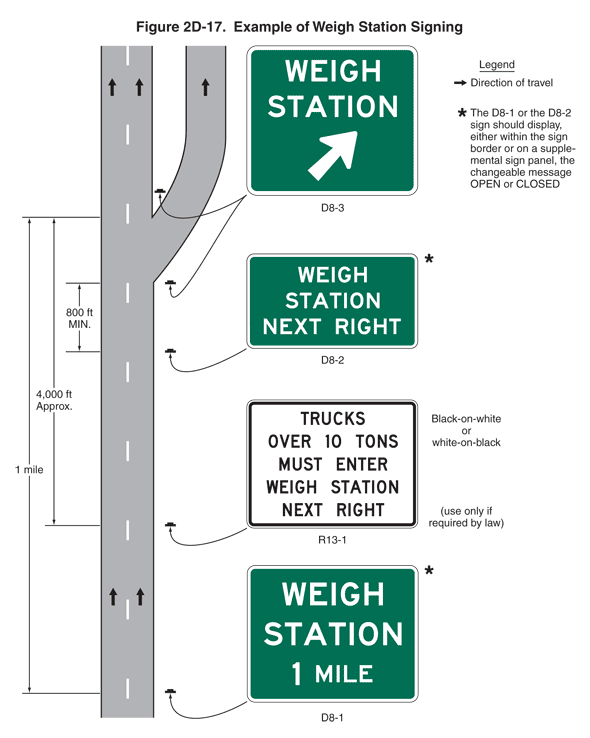
Option:
04 Where State law requires a regulatory sign (R13-1) in advance of the Weigh Station, a fourth sign (see Section 2B.60) may be located following the Advance sign.
Guidance:
05 The Exit Direction sign (D8-2) or the Advance sign (D8-1) should display, either within the sign border or on a supplemental plaque or sign panel, the changeable message OPEN or CLOSED.
Section 2D.50 Community Wayfinding Signs
Support:
01 Community wayfinding guide signs are part of a coordinated and continuous system of signs that direct tourists and other road users to key civic, cultural, visitor, and recreational attractions and other destinations within a city or a local urbanized or downtown area.
02 Community wayfinding guide signs are a type of destination guide sign for conventional roads with a common color and/or identification enhancement marker for destinations within an overall wayfinding guide sign plan for an area.
03 Figures 2D-18 through 2D-20 illustrate various examples of the design and application of community wayfinding guide signs.
Figure 2D-18 Examples of Community Wayfinding Guide Signs
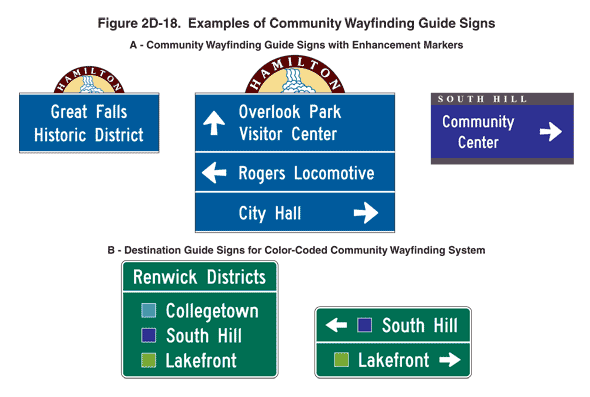
Figure 2D-19 Example of a Community Wayfinding Guide Sign System Showing Direction from a Freeway or Expressway
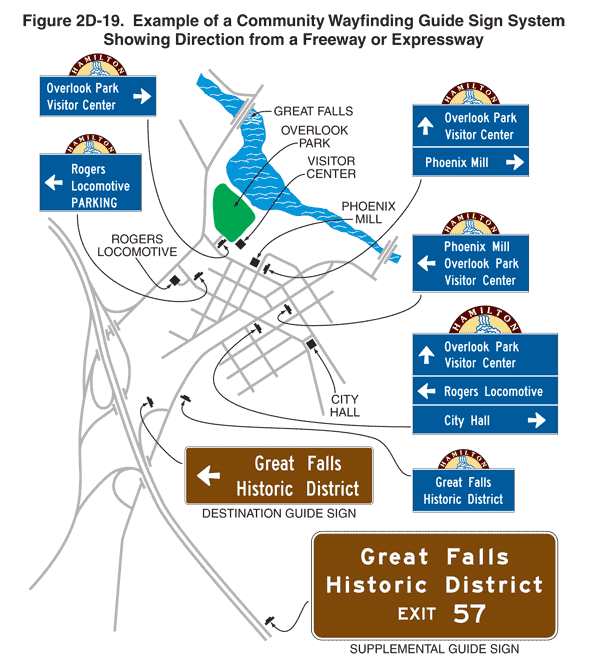
Figure 2D-20 Example of a Color-Coded Community Wayfinding Guide Sign System

Standard:
04 The use of community wayfinding guide signs shall be limited to conventional roads. Community wayfinding guide signs shall not be installed on freeway or expressway mainlines or ramps. Direction to community wayfinding destinations from a freeway or expressway shall be limited to the use of a Supplemental Guide sign (see Section 2E.35) on the mainline and a Destination sign (see Section 2D.37) on the ramp to direct road users to the area or areas within which community wayfinding guide signs are used. The individual wayfinding destinations shall not be displayed on the Supplemental Guide and Destination signs except where the destinations are in accordance with the State or agency policy on Supplemental Guide signs.
05 Community wayfinding guide signs shall not be used to provide direction to primary destinations or highway routes or streets. Destination or other guide signs shall be used for this purpose as described elsewhere in this Chapter and shall have priority over any community wayfinding sign in placement, prominence, and conspicuity.
06 Because regulatory, warning, and other guide signs have a higher priority, community wayfinding guide signs shall not be installed where adequate spacing cannot be provided between the community wayfinding guide sign and other higher priority signs. Community wayfinding guide signs shall not be installed in a position where they would obscure the road users' view of other traffic control devices.
07 Community wayfinding guide signs shall not be mounted overhead.
Guidance:
08 If used, a community wayfinding guide sign system should be established on a local municipal or equivalent jurisdictional level or for an urbanized area of adjoining municipalities or equivalent that form an identifiable geographic entity that is conducive to a cohesive and continuous system of signs. Community wayfinding guide signs should not be used on a regional or statewide basis where infrequent or sparse placement does not contribute to a continuous or coordinated system of signing that is readily identifiable as such to the road user. In such cases, Destination or other guide signs detailed in this Chapter should be used to direct road users to an identifiable area in which the type of eligible destination described in Paragraph 1 is located.
Support:
09 The specific provisions of this Section regarding the design of community wayfinding sign legends apply to vehicular community wayfinding signs and do not apply to those signs that are intended only to provide information or direction to pedestrians or other users of a sidewalk or roadside area.
Guidance:
10 Because pedestrian wayfinding signs typically use smaller legends that are inadequately sized for viewing by vehicular traffic and because they can provide direction to pedestrians that might conflict with that appropriate for vehicular traffic, wayfinding signs designed for and intended to provide direction to pedestrians or other users of a sidewalk or other roadside area should be located to minimize their conspicuity to vehicular traffic. Such signs should be located as far as practical from the street, such as at the far edge of the sidewalk. Where locating such signs farther from the roadway is not practical, the pedestrian wayfinding signs should have their conspicuity to vehicular traffic minimized by employing one or a combination of the following methods:
- Locating signs away from intersections where high-priority traffic control devices are present.
- Facing the pedestrian message toward the sidewalk and away from the street.
- Cantilevering the sign over the sidewalk if the pedestrian wayfinding sign is mounted at a height consistent with vehicular traffic signs, removing the pedestrian wayfinding signs from the line of sight in a sequence of vehicular signs.
11 To further minimize their conspicuity to vehicular traffic during nighttime conditions, pedestrian wayfinding signs should not be retroreflective.
Support:
12 Color coding is sometimes used on community wayfinding guide signs to help road users distinguish between multiple potentially confusing traffic generator destinations located in different neighborhoods or subareas within a community or area.
Option:
13 At the boundaries of the geographical area within which community wayfinding guide signing is used, an informational guide sign (see Figures 2D-18 and 2D-20) may be posted to inform road users about the presence of wayfinding signing and to identify the meanings of the various color codes or pictographs that are being used.
Standard:
14 These informational guide signs shall have a white legend and border on a green background and shall have a design similar to that illustrated in Figures 2D-1 and 2D-18 and shall be consistent with the basic design principles for guide signs. These informational guide signs shall not be installed on freeway or expressway mainlines or ramps.
15 The color coding or a pictograph of the identification enhancement markers of the community wayfinding guide signing system shall be included on the informational guide sign posted at the boundary of the community wayfinding guide signing area. The color coding or pictographs shall apply to a specific, identifiable neighborhood or geographical subarea within the overall area covered by the community wayfinding guide signing. Color coding or pictographs shall not be used to distinguish between different types of destinations that are within the same designated neighborhood or subarea. The color coding shall be accomplished by the use of different colored square or rectangular panels on the face of the informational guide sign, each positioned to the left of the neighborhood or named geographic area to which the color-coding panel applies. The height of the colored square or rectangular panels shall not exceed two times the height of the upper-case letters of the principal legend on the sign.
Option:
16 The different colored square or rectangular panels may include either a black or a white (whichever provides the better contrast with the color of the panel) letter, numeral, or other appropriate designation to identify the destination.
17 Except for the informational guide sign posted at the boundary of the wayfinding guide sign area, community wayfinding guide signs may use background colors other than green in order to provide a color identification for the wayfinding destinations by geographical area within the overall wayfinding guide signing system. Color-coded community wayfinding guide signs may be used with or without the boundary informational guide sign displaying corresponding color-coding panels described in Paragraphs 13 through 16. Except as provided in Paragraphs 18 and 19, in addition to the colors that are approved in this Manual for use on official traffic control signs (see Section 2A.10), other background colors may also be used for the color coding of community wayfinding guide signs.
Standard:
18 The standard colors of red, orange, yellow, purple, or the fluorescent versions thereof, fluorescent yellow-green, and fluorescent pink shall not be used as background colors for community wayfinding guide signs, in order to minimize possible confusion with critical, higher-priority regulatory and warning sign color meanings readily understood by road users.
19 The minimum luminance ratio of legend to background for community wayfinding guide signs shall be 3:1.
20 All messages, borders, legends, and backgrounds of community wayfinding guide signs and any identification enhancement markers shall be retroreflective (see Sections 2A.07 and 2A.08).
Guidance:
21 Community wayfinding guide signs, exclusive of any identification enhancement marker used, should be rectangular in shape. Simplicity and uniformity in design, position, and application as described in Section 2A.06 are important and should be incorporated into the community wayfinding guide sign design and location plans for the area.
22 Community wayfinding guide signs should be limited to three destinations per sign (see Section 2D.07).
23 Abbreviations (see Section 1A.15) should be kept to a minimum, and should include only those that are commonly recognized and understood.
24 Horizontal lines of a color that contrasts with the sign background color should be used to separate groups of destinations by direction from each other.
Support:
25 The basic requirement for all highway signs, including community wayfinding signs, is that they be legible to those for whom they are intended and that they be understandable in time to permit a proper response. Section 2A.06 contains additional information on the design of signs, including desirable attributes of effective designs.
Guidance:
26 Word messages should be as brief as practical and the lettering should be large enough to provide the necessary legibility distance.
Standard:
27 The minimum specific ratio of letter height to legibility distance shall comply with the provisions of Section 2A.13. The size of lettering used for destination and directional legends on community wayfinding signs shall comply with the provisions of minimum letter heights as provided in Section 2D.06.
28 Interline and edge spacing shall comply with the provisions of Section 2D.06.
29 Except as provided in Paragraph 31, the lettering style used for destination and directional legends on community wayfinding guide signs shall comply with the provisions of Section 2D.05.
30 The lettering for destinations on community wayfinding guide signs shall be a combination of lower-case letters with initial upper-case letters (see Section 2D.05). All other word messages on community wayfinding guide signs shall be in all upper-case letters.
Option:
31 A lettering style other than the Standard Alphabets provided in the "Standard Highway Signs and Markings" book may be used on community wayfinding guide signs if an engineering study determines that the legibility and recognition values for the chosen lettering style meet or exceed the values for the Standard Alphabets for the same legend height and stroke width.
Standard:
32 Except for signs that are intended to be viewed only by pedestrians, bicyclists stopped out of the flow of traffic, or occupants of parked vehicles, Internet and e-mail addresses, including domain names and uniform resource locators (URL), shall not be displayed on any community wayfinding guide sign or sign assembly.
33 The arrow location and priority order of destinations shall follow the provisions described in Sections 2D.08 and 2D.37. Arrows shall be of the designs provided in Section 2D.08.
Option:
34 Pictographs (see definition in Section 1A.13) may be used on community wayfinding guide signs.
Standard:
35 If a pictograph is used, its height shall not exceed two times the height of the upper-case letters of the principal legend on the sign.
36 Except for pictographs, symbols that are not approved in this Manual for use on guide signs shall not be used on community wayfinding guide signs.
37 Business logos, commercial graphics, or other forms of advertising (see Section 1A.01) shall not be used on community wayfinding guide signs or sign assemblies.
Option:
38 Other graphics that specifically identify the wayfinding system, including identification enhancement markers, may be used on the overall sign assembly and sign supports.
Support:
39 An enhancement marker consists of a shape, color, and/or pictograph that is used as a visual identifier for the community wayfinding guide signing system for an area. Figure 2D-18 shows examples of identification enhancement marker designs that can be used with community wayfinding guide signs.
Option:
40 An identification enhancement marker may be used in a community wayfinding guide sign assembly, or may be incorporated into the overall design of a community wayfinding guide sign, as a means of visually identifying the sign as part of an overall system of community wayfinding signs and destinations.
Standard:
41 The sizes and shapes of identification enhancement markers shall be smaller than the community wayfinding guide signs themselves. Identification enhancement markers shall not be designed to have an appearance that could be mistaken by road users as being a traffic control device.
Guidance:
42 The area of the identification enhancement marker should not exceed 1/5 of the area of the community wayfinding guide sign with which it is mounted in the same sign assembly.
Section 2D.51 Truck, Passing, or Climbing Lane Signs (D17-1 and D17-2)
Guidance:
01 If an extra lane has been provided for trucks and other slow-moving traffic, a NEXT TRUCK LANE XX MILES (D17-1) sign and/or a TRUCK LANE XX MILES (D17-2) sign (see Figure 2D-21) should be installed in advance of the lane.
Figure 2D-21 Crossover, Truck Lane, and Slow Vehicle Signs
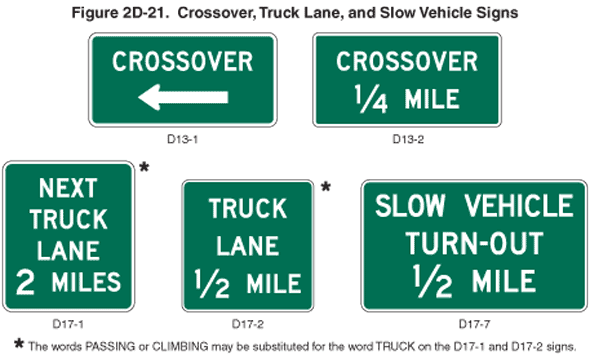
Option:
02 Alternative legends such as PASSING LANE or CLIMBING LANE may be used instead of TRUCK LANE.
03 Section 2B.31 contains information regarding regulatory signs for these types of lanes.
Section 2D.52 Slow Vehicle Turn-Out Sign (D17-7)
Guidance:
01 If a slow vehicle turn-out area has been provided for slow-moving traffic, a SLOW VEHICLE TURN-OUT XX MILES (D17-7) sign (see Figure 2D-21) should be installed in advance of the turn-out area.
Option:
02 Section 2B.35 contains information regarding regulatory signs for slow vehicle turn-out areas.
Section 2D.53 Signing of Named Highways
Option:
01 Guide signs may contain street or highway names if the purpose is to enhance driver communication and guidance; however, they are to be considered as supplemental information to route numbers.
Standard:
02 Highway names shall not replace official numeral designations.
03 Memorial names (see Section 2M.10) shall not appear on supplemental signs or on any other information sign on or along the highway or its intersecting routes.
04 The use of route signs shall be restricted to signs officially used for guidance of traffic in accordance with this Manual and the "Purpose and Policy" statement of the American Association of State Highway and Transportation Officials that applies to Interstate and U.S. numbered routes (see Page i for AASHTO's address).
Option:
05 Unnumbered routes having major importance to proper guidance of traffic may be signed if carried out in accordance with the aforementioned policies. For unnumbered highways, a name to enhance route guidance may be used where the name is applied consistently throughout its length.
Guidance:
06 Only one name should be used to identify any highway, whether numbered or unnumbered.
Section 2D.54 Crossover Signs (D13-1 and D13-2)
Option:
01 Crossover signs may be installed on divided highways to identify median openings not otherwise identified by warning or other guide signs.
Standard:
02 A CROSSOVER (D13-1) sign (see Figure 2D-21) shall not be used to identify a median opening that is permitted to be used only by official or authorized vehicles. If used, the sign shall be a horizontal rectangle of appropriate size to carry the word CROSSOVER and a horizontal directional arrow. The CROSSOVER sign shall have a white legend and border on a green background.
Guidance:
03 If used, the CROSSOVER sign should be installed immediately beyond the median opening, either on the right-hand side of the roadway or in the median.
Option:
04 The Advance Crossover (D13-2) sign (see Figure 2D-21) may be installed in advance of the CROSSOVER sign to provide advance notice of the crossover.
Standard:
05 If used, the Advance Crossover sign shall be a horizontal rectangle of appropriate size to carry the word CROSSOVER and the distance to the median opening. The sign shall have white legend and border on a green background.
Guidance:
06 The distance displayed on the Advance Crossover sign should be 1 MILE, 1/2 MILE, or 1/4 MILE, unless unusual conditions require some other distance. If used, the sign should be installed either on the right-hand side of the roadway or in the median at approximately the distance displayed on the sign.
Section 2D.55 National Scenic Byways Signs (D6-4, D6-4a)
Support:
01 Certain roads have been designated by the U.S. Secretary of Transportation as National Scenic Byways or All-American Roads based on their archeological, cultural, historic, natural, recreational, or scenic qualities.
Option:
02 State and local highway agencies may install the National Scenic Byways (D6-4 or D6-4a) signs at entrance points to a route that has been recognized by the U.S. Secretary of Transportation as a National Scenic Byway or an All-American Road. The D6-4 or D6-4a sign may be installed on route sign assemblies (see Figure 2D-22) or as part of larger roadside structures. National Scenic Byways signs may also be installed at periodic intervals along the designated route and at intersections where the designated route turns or follows a different numbered highway. At locations where roadside features have been developed to enhance the traveler's experience such as rest areas, historic sites, interpretive facilities, or scenic overlooks, the National Scenic Byways sign may be placed on the associated sign assembly to inform travelers that the site contributes to the byway travel experience.
Figure 2D-22 Examples of Use of the National Scenic Byways Sign
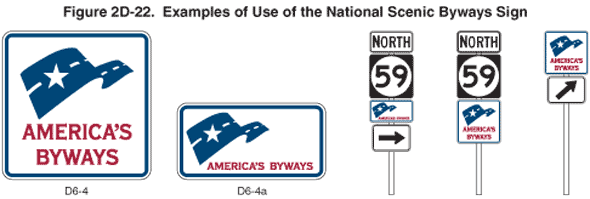
Standard:
03 When a National Scenic Byways sign is installed on a National Scenic Byway or an All-American Road, the design shown for the D6-4 or D6-4a sign in Figure 2D-22 shall be used. Use of this design shall be limited to routes that have been designated as a National Scenic Byway or All-American Road by the U.S. Secretary of Transportation.
04 If used, the D6-4 or D6-4a sign shall be placed such that the roadway route signs have primary visibility for the road user.
